If the air temperature is comfortable for you, then it is comfortable for your avocado tree.
Optimum temperature for avocado trees
It’s tempting to think of avocados as loving heat because they originated in the tropics, but we must remember that they come from high elevations where temperatures are surprisingly cool. (The avocado varieties that perform well in California do anyway.) Plant explorer Wilson Popenoe once estimated that California’s avocado-growing climate corresponds closely to the climates he experienced in Guatemala at between 6,000 and 7,000 feet in elevation. (“Exploring Guatemala for Desirable New Avocados” in the California Avocado Society Yearbook 1917.)
Getting more specific, one pair of researchers at the University of California estimated that avocados grow best at between 68 and 75 degrees. (See details in this paper.) Now, is that not about where you’d like your daytime thermostat set?
So yes indeed, avocados grow beautifully in Carpinteria, where summertime temperatures are near optimum.
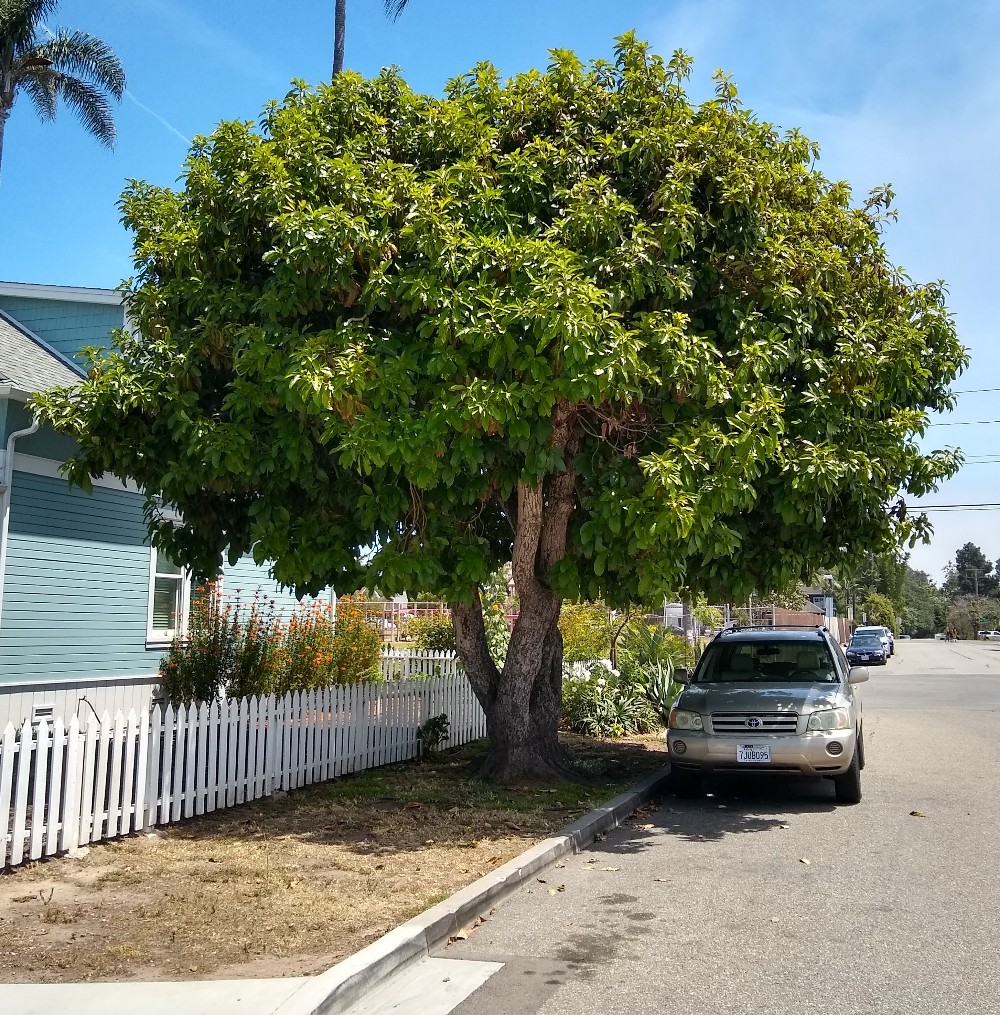
How hot is too hot for avocado trees? Protect them when over 75 degrees?
Fortunately, avocado trees can thrive in heat well above 75 degrees as long as they’re watered sufficiently. But there does come a point on the thermometer at which an avocado tree suffers regardless of how much moisture is in the soil.
Apparently, above roughly 90 degrees avocado trees begin to function poorly. Specifically, the holes in their leaves (called stomata or stomates), which sort of breathe for the tree, begin to close above about 90. (Read more on that here and here.)
Protect an avocado tree when it’s over 90 degrees?
Does this mean we must come to the rescue of our avocado trees when temperatures break the 90-degree barrier? Maybe, maybe not. Depends on the tree and where it’s growing, in addition to how much attention you’re interested in giving it and how much you care about its appearance.
Watering sufficiently is defense number one
Watering enough is absolutely the most important thing you can do to help an avocado tree cope with heat above its comfort zone.
Here is one avocado tree, a young Sharwil, that was slightly damaged by a 103-degree day:
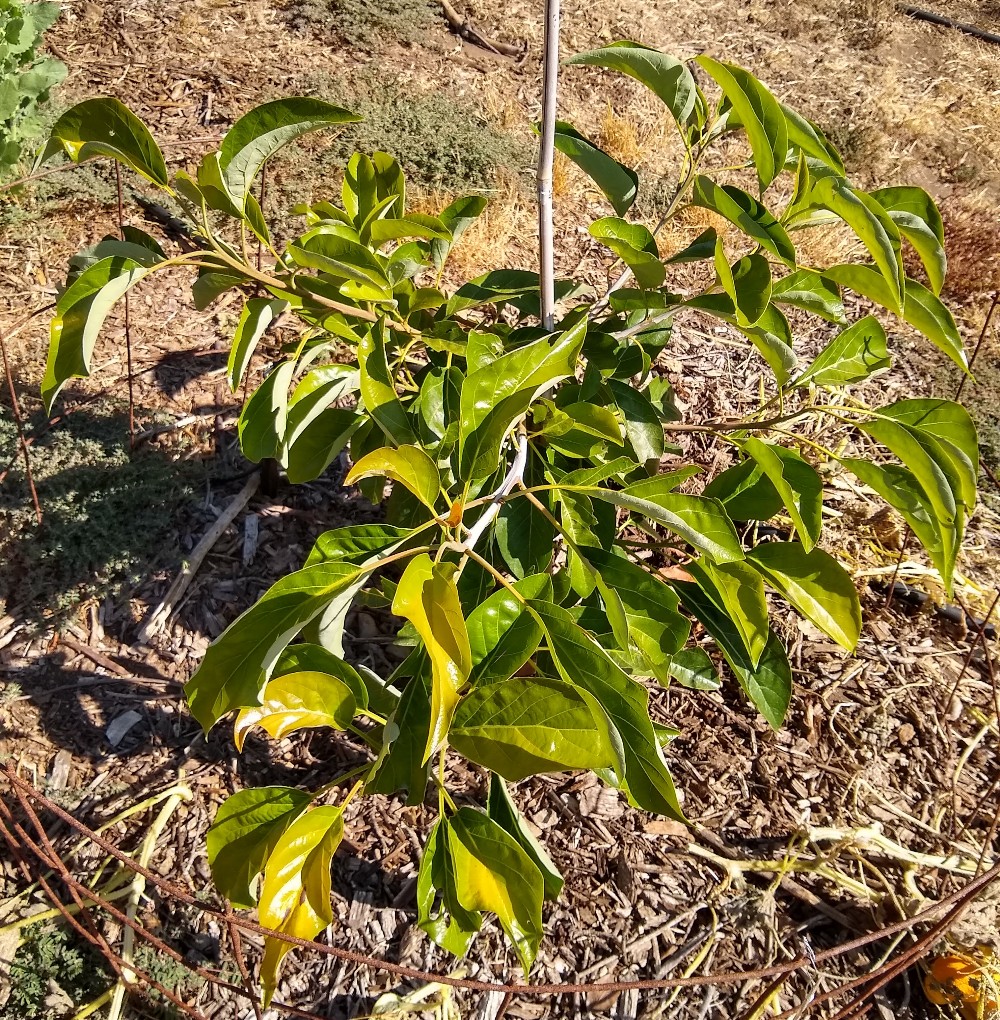
Do you even notice the damage? Some leaves are bleached.
An interpretation might be that if the temperature is just over 100 for a few days, a young tree that is healthy overall and watered well should only get some bleaching on a few leaves. That’s not real damage. Because of that, my rule of thumb is that unless it’s over 105 degrees, protection beyond good watering is unnecessary to prevent a healthy avocado tree from real damage.
Shading young trees
But what if you don’t like bleached leaves? I don’t. So I shaded most of my other young avocado trees while I was away. Here is another young Sharwil tree that had been shaded with a piece of 60-percent shade cloth overhead:
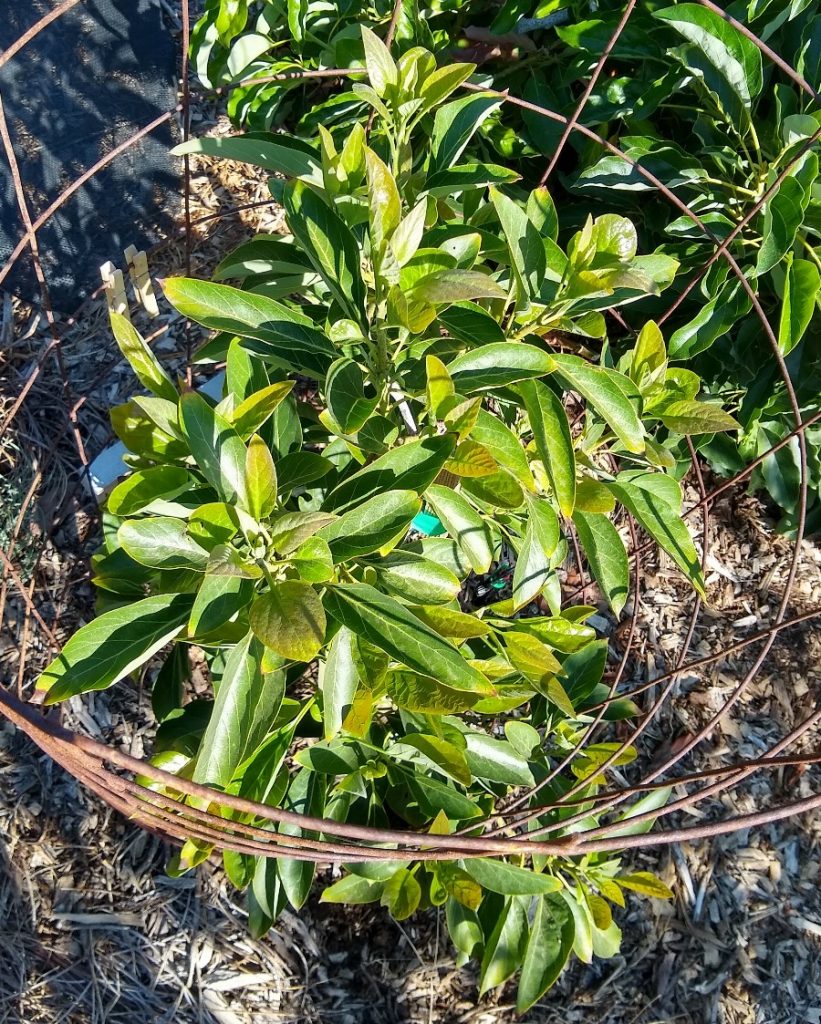
Unbleached foliage because of the midday protection from the shade cloth. The way I use shade cloth for my young trees when I’m home (not on vacation) is usually to place some over the top if the temperature gets around 95 degrees or over. I use clothespins to fasten it to the top of a cage.
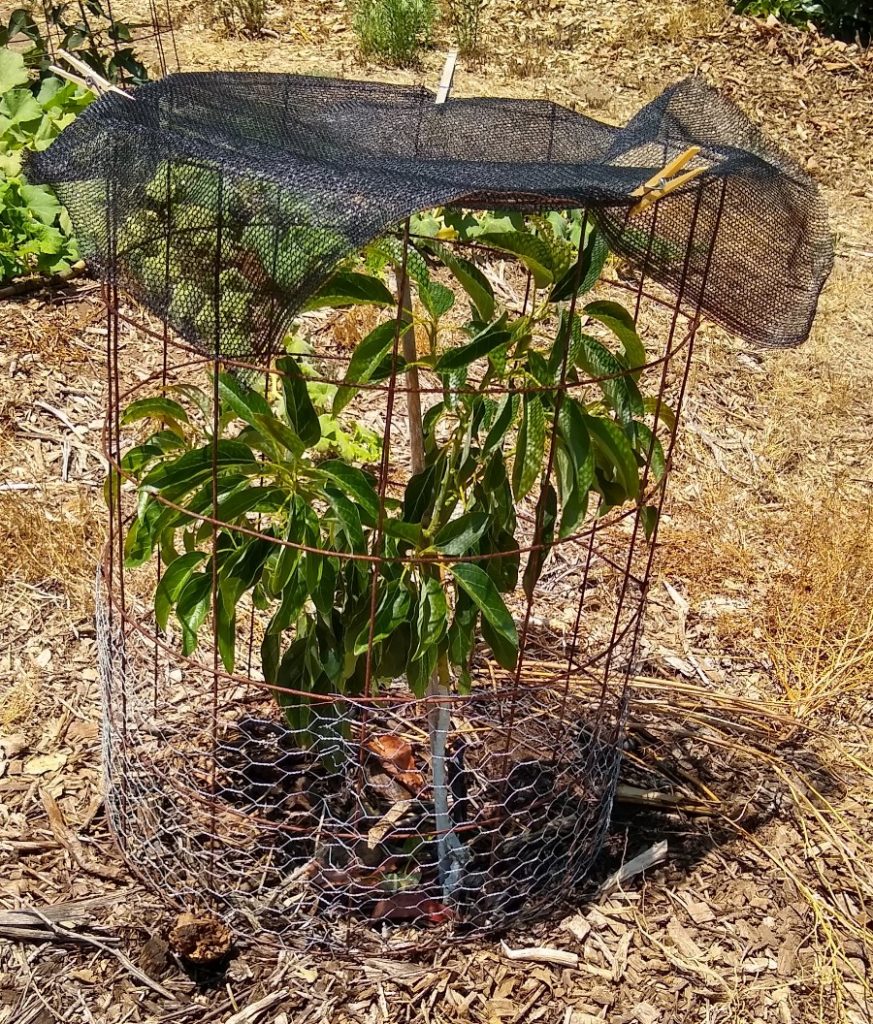
Sometimes though, I leave the shade cloth in place for most of a baby tree’s entire first summer, as I live in a relatively hot part of Southern California (Ramona) where the average daily high temperature in summer is about 90. I’ve found that if the cage holds the shade cloth high enough above the top of the tree, then the 60-percent shade in the middle of every day is enough and not too much. But if the shade cloth is closer to the tree or wrapping the sides at all, you want no more than 30 percent or else you’re shading it more than necessary and slowing down growth.
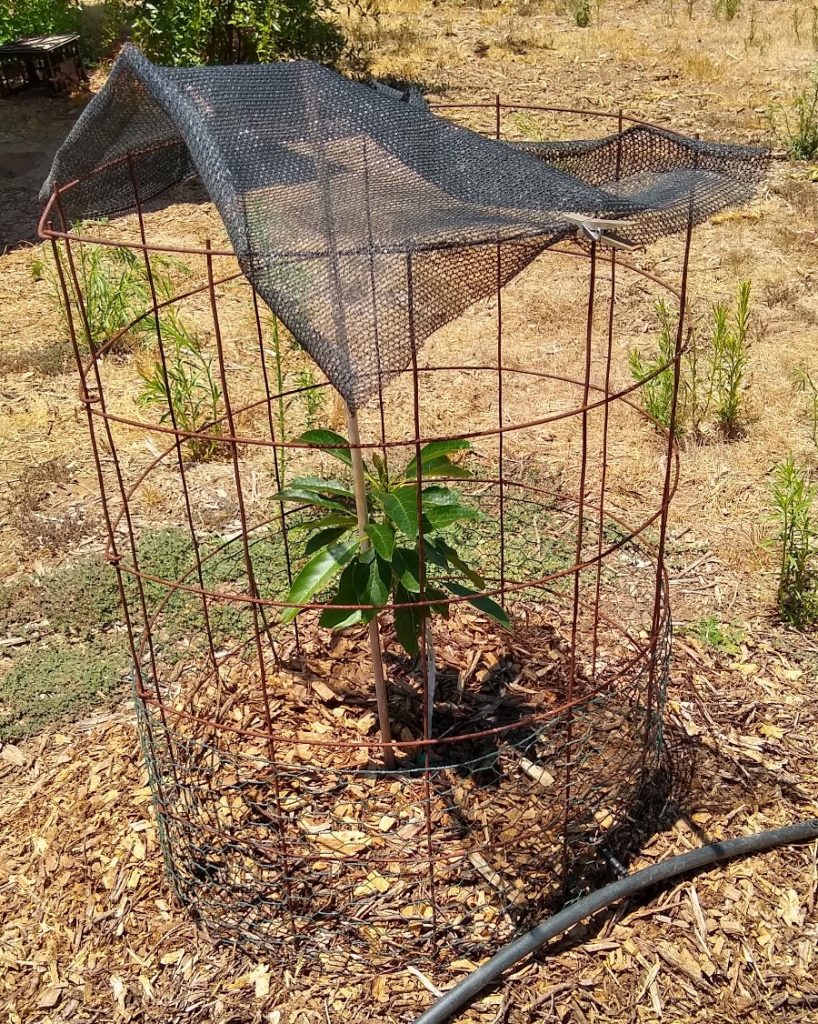
Shade can help a young tree get through the worst of Southern California heatwaves. Remember July 2018? The nearby weather station for the National Weather Service registered 118 degrees while my shaded front porch was still 113 degrees two days in a row. Some young avocado trees out in the yard would have been cooked without shade, but I doubled up 60-percent shade cloth over them in the middle of the day and they didn’t show a bit of stress. (Other unshaded avocado trees nearby were sunburned so badly that entire branches died.)
Other methods of providing shade to young trees include setting up a beach umbrella for the day or posting four stakes around the tree and stretching burlap across.
A grower in Riverside erected this shade structure over his young avocados, and it has helped his trees get through high heat:
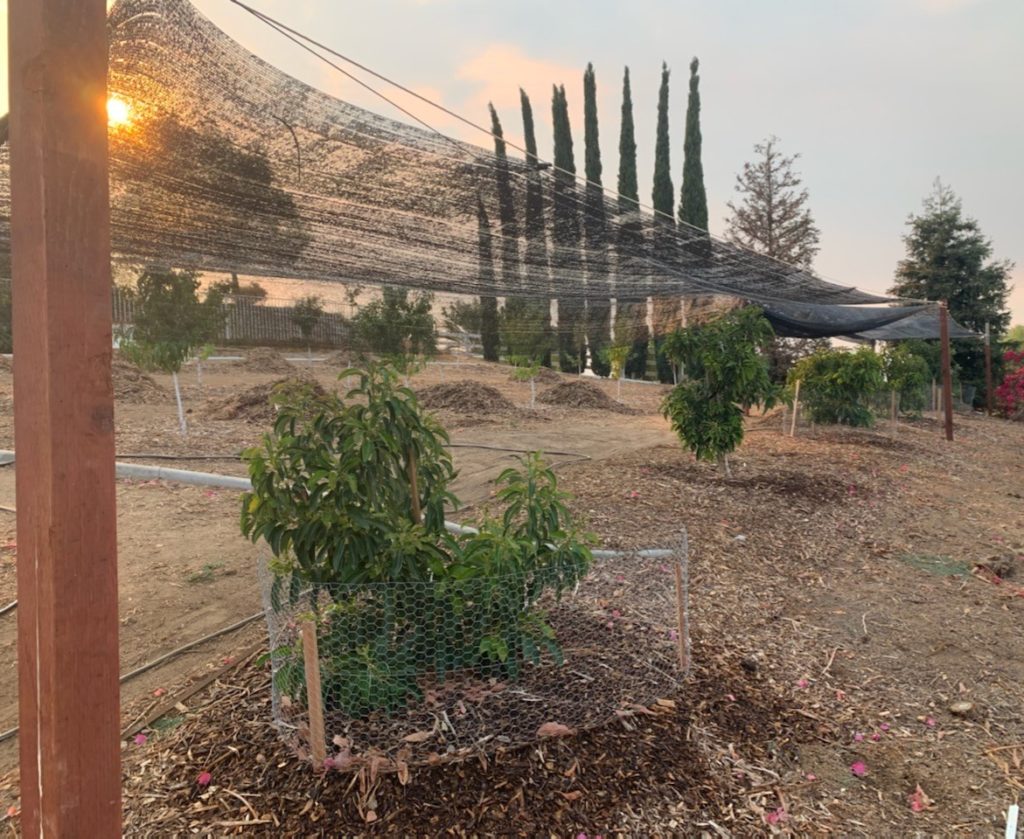
Painting young trees
One more thing that is most relevant to protecting a young avocado tree from heat is painting its branches and trunk.
I noticed a young Hass avocado tree while I was in Carpinteria that had a bare branch exposed to the western sun but was barely bronzed.

That branch would be blackened and cracking if it had gone through the 100-degree days in my yard. If you live in a climate like Carpinteria, you can get away with leaving such a branch unprotected. But if you live inland, you’d be wise to paint such a branch on a young tree lest it get sunburned and possibly die in the long run. Young trees often don’t have the mass of canopy to protect themselves like older trees do, and they need our sunscreen to help.
Painting branches is also often called “whitewashing,” and many materials are used to get the effect. I use white latex paint mixed with one part water.
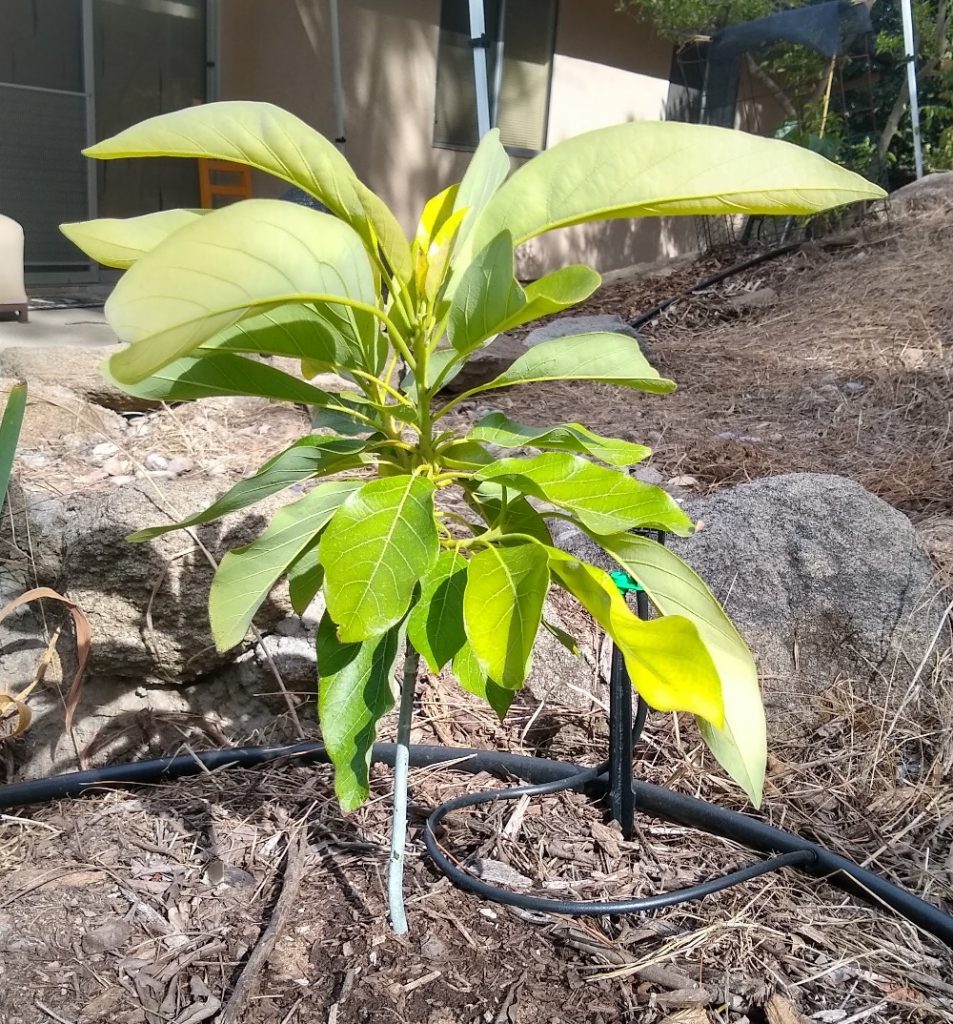
Some people also use a kaolin clay product called “Surround”. It can even be sprayed on leaves to protect them from sunburn.
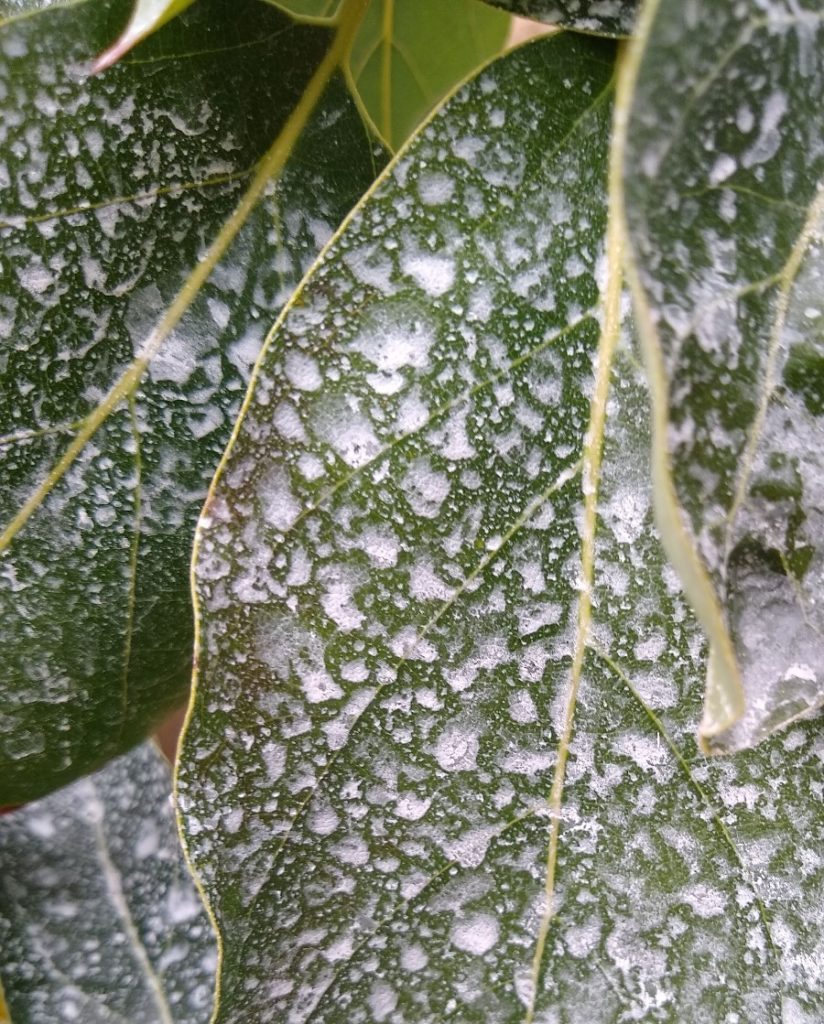
But I’m not sure how effective Surround is in protecting avocado foliage in high heat. During the September 5 and 6, 2020 heat wave, where my yard reached 115 degrees, I sprayed some trees with Surround. On my Nimlioh avocado tree in particular, I sprayed only the tip of one branch with new growth to see if it would fare better than the unsprayed branches nearby. I didn’t notice any difference. Do you?
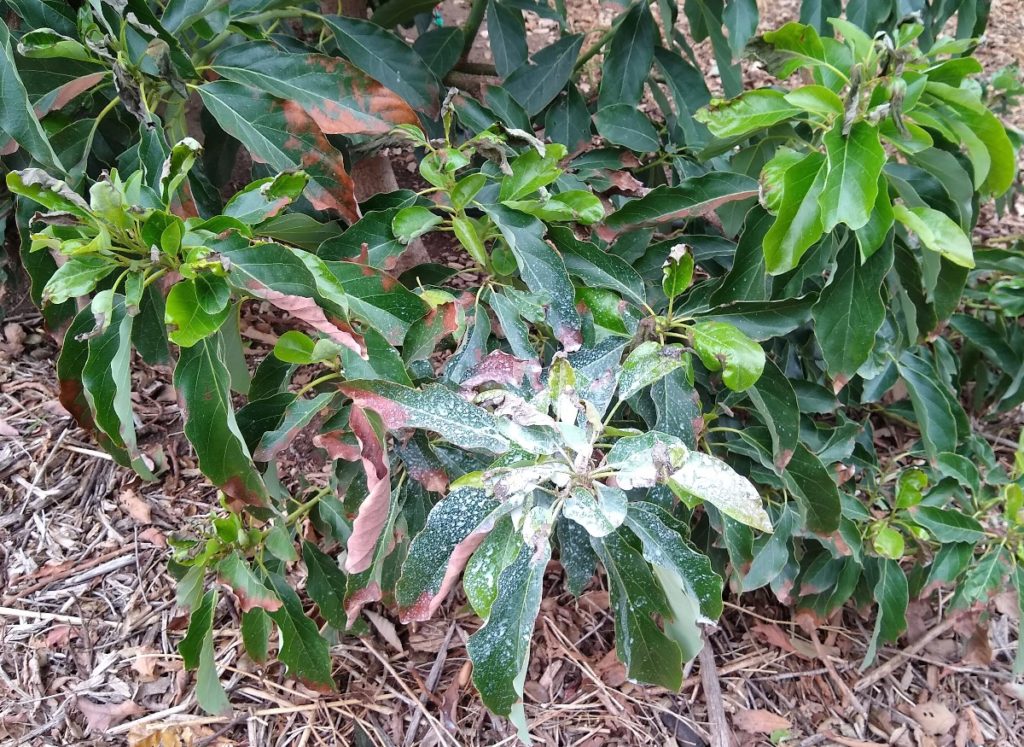
For more on avocado sunburn, see my post “Avocado trees get sunburned — what to do?”
Mulching or growing companion plants
Avocado roots like to grow right at the surface of the soil if they can. If it’s hot there, they can’t. Mulch keeps that level of the soil comfortably cool and hospitable to avocado roots. The more roots a tree has, the more water it can draw up into its canopy to cool itself. I like to use wood chips around my avocado trees.
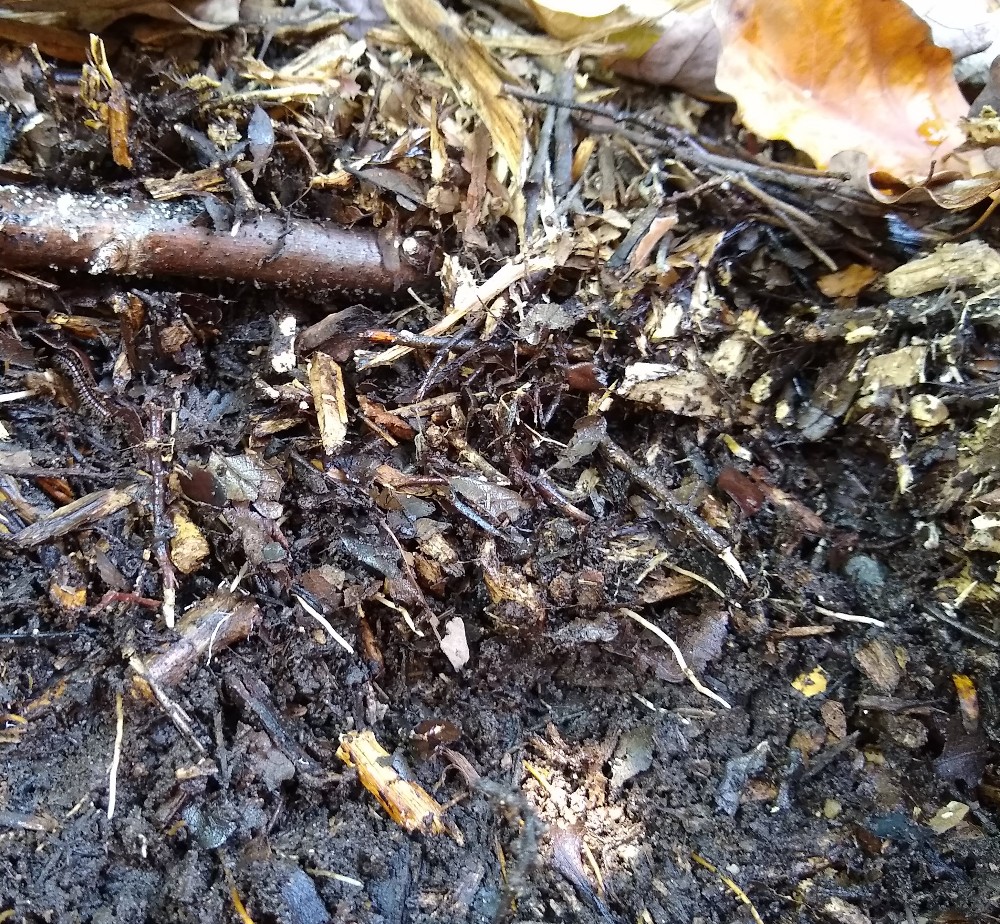
One day it was in the mid-90s and I felt the wood chips and then felt the bare dirt near the wood chips. The bare dirt was noticeably hotter, and it was so hot that I couldn’t keep my hand pressed down for long. That kind of temperature fries avocado roots. I’ve seen it happen where my chickens have scratched the mulch away in a spot. The revealed roots brown and shrivel rapidly.
Wood chips are not the only option for cooling the soil surface around an avocado tree. I often grow a vine or two on the ground near a young avocado tree, and one reason is to reduce the heat and increase the humidity in that immediate environment.
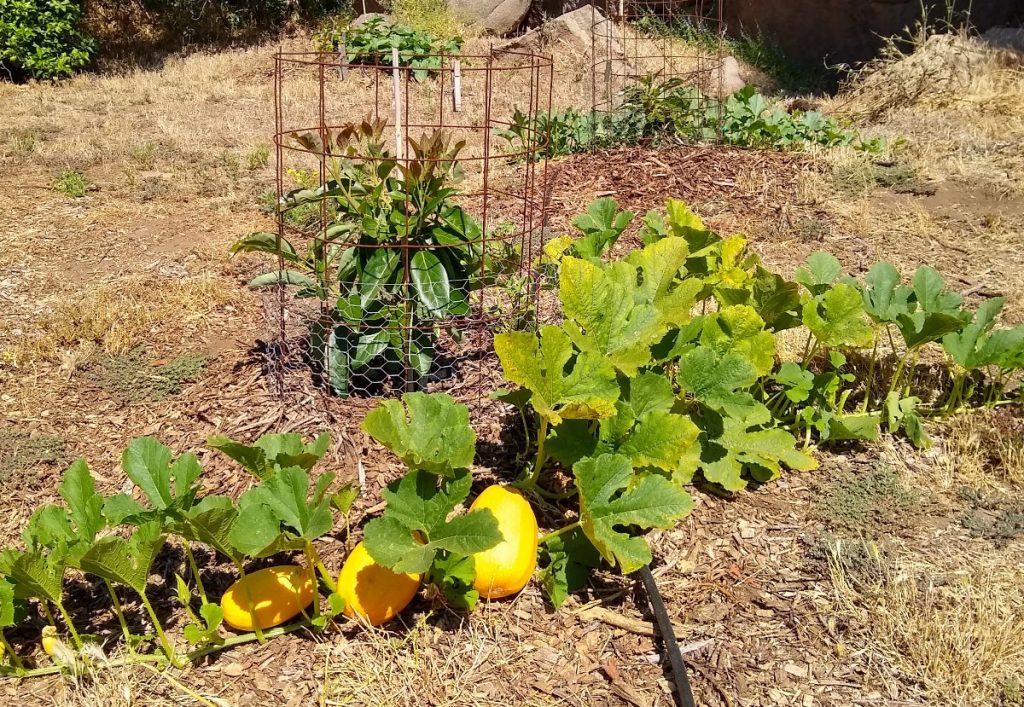
Sprinkling during heatwaves
Usually, in Southern California, when it’s over 100 degrees the humidity is very low. This makes it even harder for an avocado tree to manage the heat. Think of how much more thirsty you get when there’s a spell of Santa Anas and the relative humidity is less than 20 percent.
Pulsing sprinklers
During such heat, I run the micro-sprinklers under my trees for 15-30 minutes in the middle of the day — sometimes once every hour or two throughout the afternoon — in order to raise the humidity under the tree and within its canopy. I’ve seen a tree with wilting leaves perk up after such a pulse, indicating that it has given the tree welcome relief.

I usually only run these pulses if it’s around 105 or higher.
Spraying for evaporative cooling
I also sometimes spray a tree’s leaves if it’s 105 or higher. This works to cool a tree even better. The tree shows relief almost instantly if the leaves have wilted: within minutes they become turgid and look normal again.
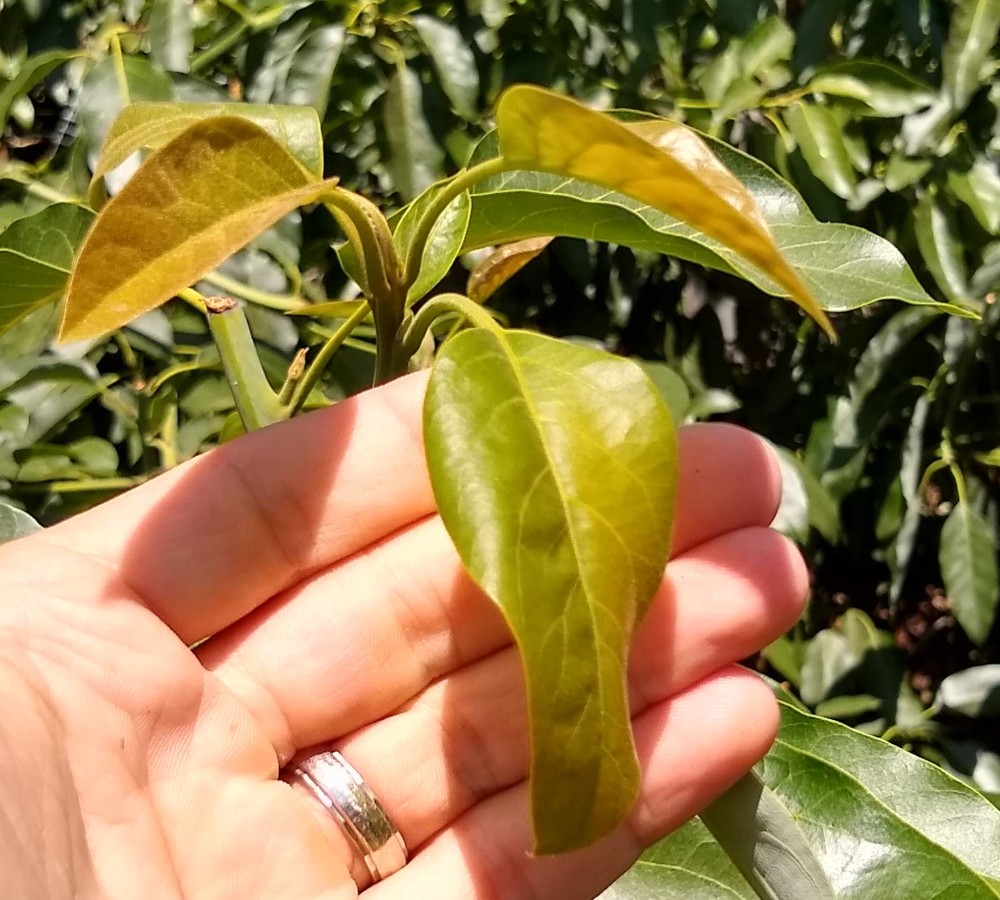
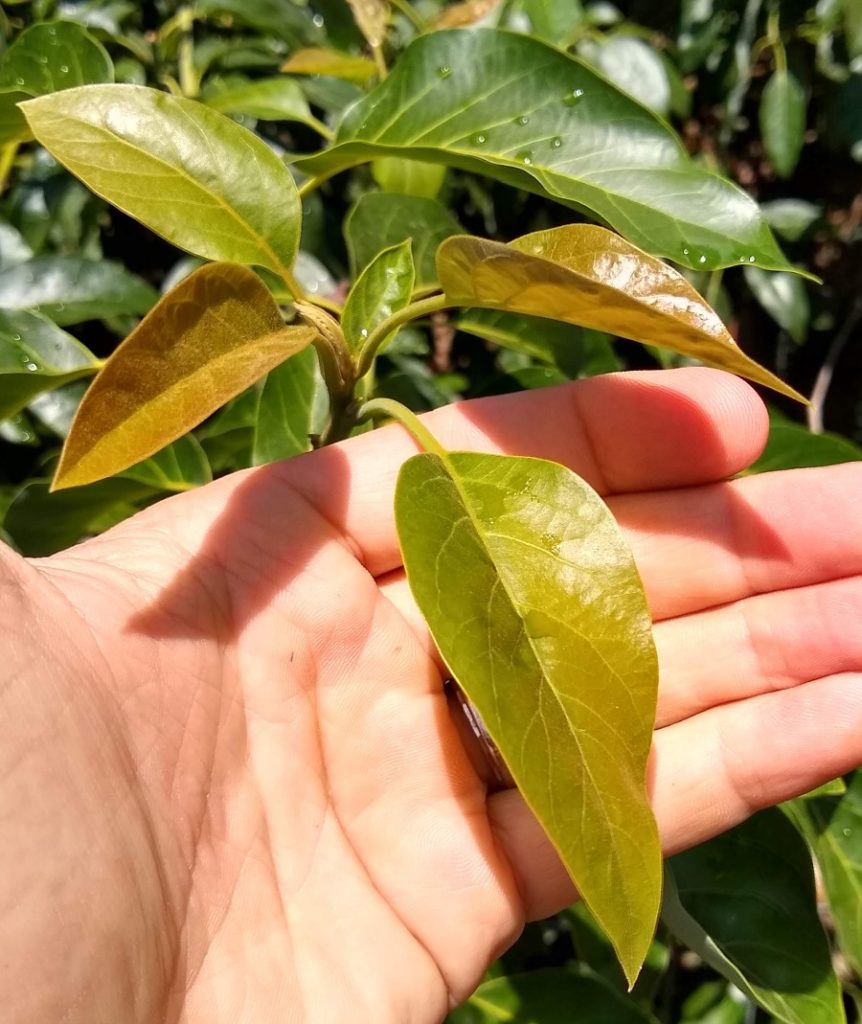
This evaporative cooling method has been used on avocados for over a hundred years, and it was formally studied back in the 1960s, and a report was published in the 1963 California Avocado Society Yearbook called “Cooling Avocado Trees by Sprinkling.” The report says, “Temperature reductions up to 5 and 7 degrees were obtained.”
It’s clear that wetting down a tree cools it; the challenge is how to do it economically. Spraying trees with a hose takes time and effort, and you have to be with your trees during the heat of the day (what if you’re away at work?).
In an old avocado grove, I found these Rain Bird sprinklers atop tall risers that can be used to wet down the trees during high heat:
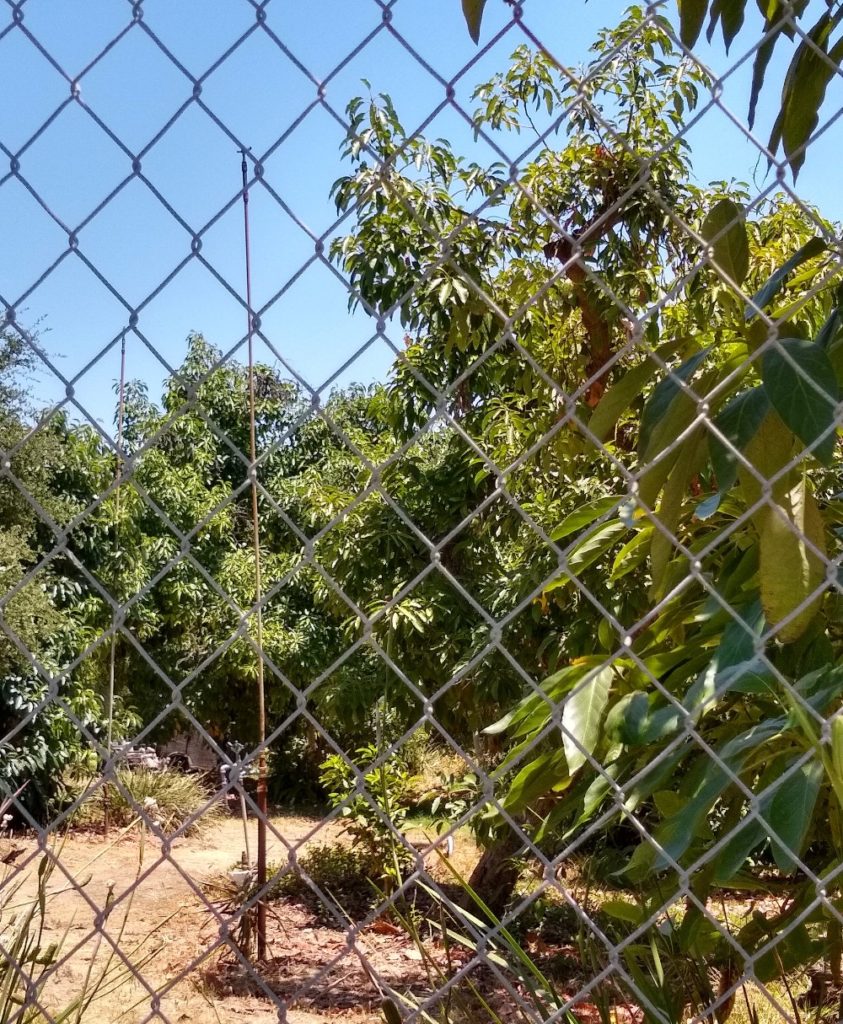
Using these old Rain Birds as inspiration, along with some advice from growers of apples and pears up in Washington, I’ve been experimenting with different designs.
Here is one of my early attempts on a young Nabal tree:
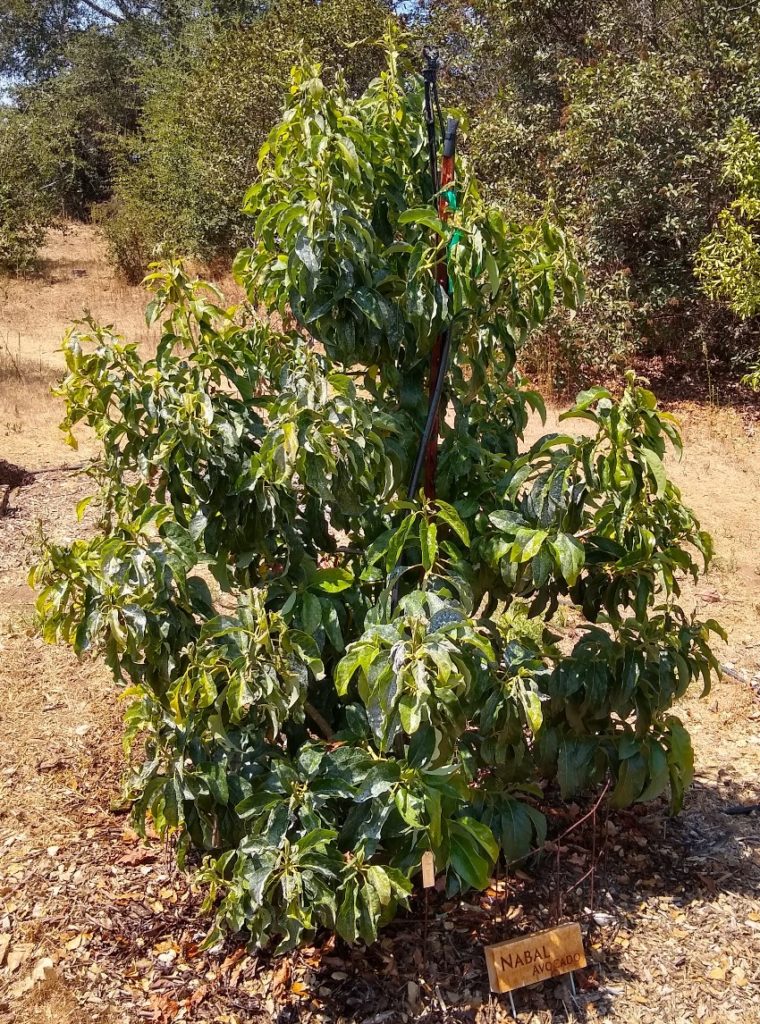
See more about this method of cooling in my post, “Overhead watering for evaporative cooling of avocado trees.”
Video
Here’s a video that shows how I protect my avocado trees from heat:
Is it worth protecting avocado trees from heat?
Can our avocado crops really be saved in hot inland locations? Is it even possible to grow avocados well here?
I will answer with the story of a visit I made this winter to a tiny avocado farm in Redlands, San Bernardino County. Do you know Redlands? It’s even hotter than Ramona, where I am. Redlands is extremely hot in the summer for avocados. The average August day in Redlands gets to 96 degrees — average.
The owner’s avocado trees should not have been growing and fruiting as well as they were. But the evidence was undeniable. His trees carried as much mature fruit as the most productive groves I’ve ever seen in more hospitable locations, like Carpinteria — and this meant that they’d carried this fruit through the July 6-8, 2018 record-setting heatwave.
How did he do it?
His baby Carmen trees were loaded:
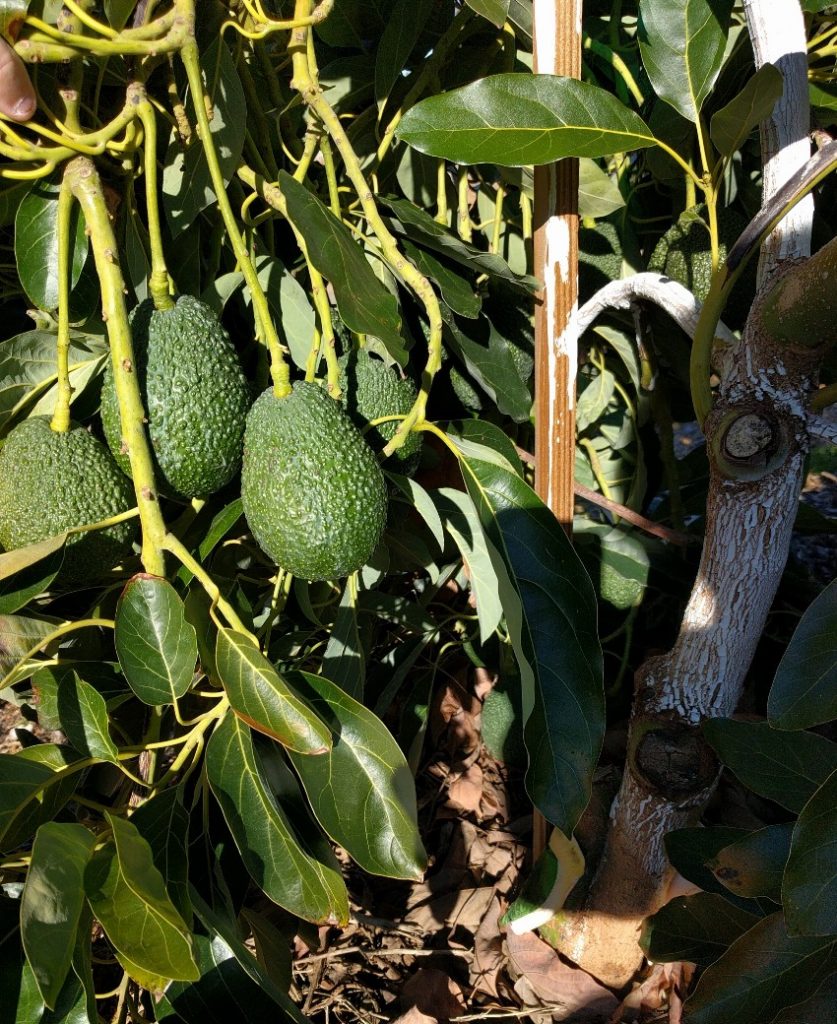
His Pinkerton tree had enough fruit to break branches:

He said to me at one point when we were walking through his grove, “My neighbors kept telling me last summer that I was watering too much. But if the new trees went a day without water they would wilt.” So for most of the summer he had watered once in the morning and once in the evening, every single day. (He used micro-sprinklers.) I probably would have also told him he was watering too much with that schedule, but I would have been wrong. Look at his trees.
How was he growing avocados so well in a hot inland location? He was doing many things right, but most importantly he was not skimping on water. Don’t skimp on water with avocados in the heat. Over a century ago, Thomas Shedden called this “the wisdom of treating the avocado with hydropathy.” It worked then, and it still works today.
Want to read more from Shedden, and to be reminded that spells of extreme heat are nothing new under the Southern California sun? A discussion among early avocado growers in Southern California after the devastating heat wave of June 1917.
All of my Yard Posts are listed HERE
Your support keeps this website up and free of ads. Learn how you can support HERE

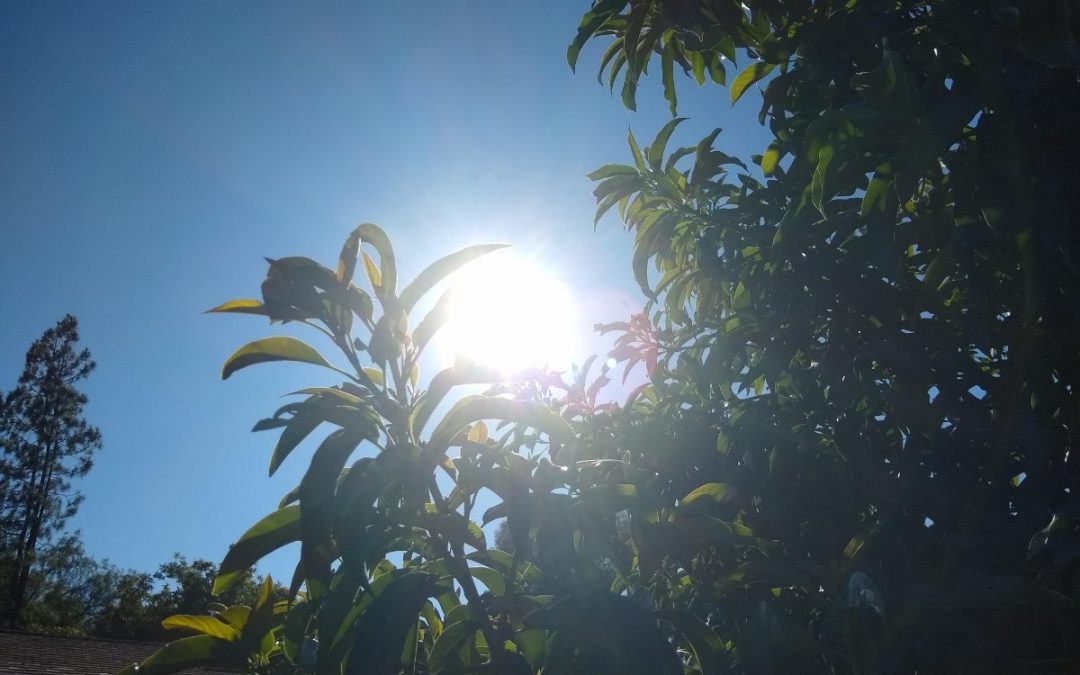


Hi Greg! When we lived in OC 3 miles from the ocean, watering my avocado trees was no big deal. Now that I’m 25 miles inland in SD, all of what you’ve shared is very helpful (only got to 98F last week). Finding the “sweet spot” for watering to match the weather is a challenge and error prone (to me). Thanks for sharing what you’ve learned along the way. Robert
Hi Greg,
I live west of Balboa Park on a Canyon where I have 2 avocado trees. I planted a baby Sharwil 2 1/2 years ago and it is growing gang busters. I planted a baby Holiday 7 years ago and it did well until 3 years ago when it suffered heat damage during a hot August (it easily gets to 90+ degrees here) when my irrigation system failed. It lost at least 14 branches and the central leader died to at least a foot and a half down. Since then, I have been trying to baby it back to health. It has put out some new branches and it flowers profusely but all fruit falls off at about olive size. Also, leaf cover is sparse at the top. I feed it Gropower citrus and avocado food every couple of months and water well twice a week. New growth is very slow-only about 6 inches this season. Is there anything else I can do to help my little tree leaf out? It is protected from strong southern sun by reed screen that allows dappled sunlight to penetrate. Thank you!
Hi Linda,
I used to live on a canyon at the north end of Balboa Park . . . and I grew a Holiday avocado tree there too! I feel like I can really envision your situation.
In the four years I grew that Holiday it never carried a single fruit to maturity. I now have a Holiday again in my current yard, and it is approaching four years old and it has also yet to carry a single fruit to maturity. Just like with your tree, mine set fruit but eventually dropped them.
For what it’s worth, I know many other Holiday trees that also don’t yield well, and these are located way inland as well as right next to the ocean. In fact, I’ve never seen a Holiday tree carrying a serious crop of avocados.
Young avocado trees of any variety don’t reliably recover from damage such as that experienced by your Holiday, in my experience. Sometimes they come back well, sometimes they don’t. I can’t figure out exactly why some do and why some don’t, which is why I often just cut down such a tree and replace it with a new, healthy one. I used to baby such trees, but I rarely do anymore.
Holiday trees are not the most vigorous variety anyway, as I’m sure you know. So maybe it will recover but you’ll need lots of patience. It sounds like you’re doing everything right to help it along. I can’t think of anything more that will help except to make sure it’s frequently watered going through late August and early September, when your area usually gets hottest.
Graft another variety on it
I would like to plant an advocado tree. I live near New Orleans. The 2023 summer heat has been record highs, averaging 96/97 with 100 in 3 or more days in a row. With climate change, I assume that will be the norm in near future. If I try your technique, will I be able grow them?
Hi Emilie,
Temperatures around 100 degrees are not a big problem for avocados, especially after they are a few years old. My yard reaches 100 at least a dozen days in an average summer. If that is your only concern (and you don’t have cold issues), then you should be fine.
I bought a 5 gallon Lamb Hass. After 6 years it finally had 2 fruit. It was still about the same size in height. I dug it out and put it in a 5 gallon container and cut the trunk down to about 12″ and grafted to it. I ended up tossing it away. I planted a red baron peach in the same hole in January 2020 and it took off giving me 4 peaches in June 2020. Some trees grow big and healthy and some are stunted and sickly and will never do well. If you think the tree has promise I suggest you dig it out of the ground, cut it back to a small size, and put it in a container with good drainage and try not to disturb the roots. Add some good soil and put it in a shaded location. Give it plenty of water. I’ve done this a couple times and it worked. Actually, I had a 15 gallon Tahoe Gold Tangerine that was doing lousy, so I dug it out and did to it what I told you to do. It grew a few new stems about 12″ long from a large truck. It just would not do much more. I decided to put it in the ground, so I held the 7 gallon container while my helper pulled it by the trunk. To our surprise it had some big brown roots (no white roots) and they pulled out of the dirt. That usually means quick death for citrus. We planted it any way. A week later my helper asked if it died. Guess what – the leaves are still green 2 weeks later. It must be growing new roots or the leaves would have turned brown by now. Miracles do happen!
I live in Sylmar located in the north east corner of the San Fernando Valley
and it can get hot in the summer. In fact, my main worry when attempting to grow avocados here is high heat not frost. I tried growing a Holiday, but gave up on it after too many burnt branches even as the tree was quite bushy.
Where I am located it seems all young avocado trees like or even require three things: Shade cloth in the summer, chips or leaves covering the soil, and micro-sprinklers supplying the water.
if you spray the tree down during the heat will it not wilt the leaves or burn it ??
Hi Greg, I live in Redlands and am trying to keep a young Reed avocado tree alive. As you might know, it has been around 100 degrees every day for a few weeks, and I started giving it more water. But its leaves are now mostly brown. The moisture meter is saying the soil is wet (not moist). Do you think I am overwatering? I will try spraying the leaves and shading, as you suggest, although unfortunately it might be too late for this one. Thanks!
Hi Mika,
So sorry to hear this. If the leaves are now mostly brown, it’s going to be a real uphill battle to get the tree through the rest of the summer since a little tree needs those leaves to protect and cool itself — not to mention to grow. But your best bet is to paint all branches and shade it until it grows new foliage.
The burning of your tree’s leaves tells me that you’re most likely not overwatering but have underwatered in the recent past. If the tree was planted this year and your soil is coarse (as I know some locations in Redlands are, at least), then it’s possible that you watered too infrequently. These relentless 100-degree days require newly planted trees in sandy soils to be watered often, maybe daily, maybe even twice a day.
If you end up having to plant a new tree, just know that we’ve all killed our share of avocado trees. I’ve even nearly killed some when I lived close to the beach where it’s more forgiving!
Hi Gregg: Thank you for your excellent article and your comment replies. You truly do love avocado tree’s or you’d never do it. I really appreciate your knowledge !!! I’m in Oceanside w/a 40yr old Fuerte. Doing OK, but still battling gophers. I’ll check out some micro-sprinklers as I currently water manually. Thanks again, Joe
Hi Gregg,
I saw your post and it was exactly what I was looking for. We have a small family owned farm in Fallbrook, CA. We have the farm for almost 5 years ago. We have been hit by the heat waves since then and lost many fruits because of it. We have planted some new avocado trees and with your suggested sun protection techniques maybe we can save some of the trees and the fruits. How effective and costly is the shading techniques you are suggesting in your article? Have you experienced a positive effect by this on your trees in recent years? I appreciate any of your feedback! Thank you much!
Hi Ceyda,
Thank you. The shadecloth technique on young trees can cost only a few dollars per tree or more, depending on which style you choose. Besides the metal cages, you can also staple shadecloth to 1×1 stakes. I know a farmer in Valley Center who does this for her newly planted trees.
Shading is very effective in high heat. I’ve seen this in my yard and in others.
Thank you Greg, appreciated your response! What do you think about the purShade spray? do you have any experience with it? would you recommend it? Thank you!
Hi Ceyda,
I’ve never tried Purshade and I don’t know anyone else who has. It sounds a lot like Surround. If you try it, let us know how it goes for you.
Hello Greg! You have helped us before and we greatly appreciate your helpful tips you provide to everyone. Our new tree (planted last August) started off the summer looking great at about 5 feet tall with 12 avocados growing its first crop. We have a structure built around the tree that can allow us to shade it with 60% shade cloth when necessary. We had the overhead shade structure up protecting it all of July, as we did not want to repeat the tragedy of last years burn. Lately, as in the past few days, we have noticed that the tree looks like it is more “droopy.” The leaves look healthy and are growing quickly. There is moisture in the ground, but not too wet. We water it twice a week. Should we be concerned with the slight drooping we see with the branches?
Hi Cristina,
Hard to say. Sometimes in the summer when an avocado tree is in a period of “flush” — when it’s growing a bunch of new leaves — those leaves can appear a little droopy even though the tree isn’t actually thirsty. When an avocado tree is thirsty (or heat stressed), the leaves will also lose their shine. And one way to test if the tree is stressed by lack of water is to . . . water it, and then observe the leaves over the next fifteen minutes or so. If they perk up obviously, then that was the problem.
Hello Greg! Well so far your suggestions have led us on a great path. Our little tree has grown quite a bit. Interestingly it is a branch that has grown off the center lead that is now heading the top. We enjoyed all twelve of our Sir Prize avocados immensely. Their flavors were the very best late January- March. The tree now stands about 9 feet tall and many more flowers this season. It is long but has filled in very nicely with leaves, looking like a giant in an avocado ghillie suit 🙂 The top three feet has a lot more young leaves and green branch exposure. Since it is so tall we are trying to figure out how to shade it for the hot summer. I’m thinking to start by painting the exposed branches with the spf paint. Would it make sense to paint all of the top branches like that? We are in Los Angeles near Glendale and see a forecast of 95 degrees by the end of the week.
Hi Cristina,
Good to hear from you. Your tree looks so healthy! It is in excellent condition to deal with this moderate heat wave we are having. Based on the pictures you sent, I wouldn’t do any pruning unless you don’t want the tree to get any taller.
It is normal for grafted avocado trees to grow those “water sprouts” that can take over in height from what previously had been the tree’s central leader. It is also acceptable to allow this to happen in many situations. In yours, I would leave it be.
Your tree is already big, and the sprout is heading up straight and in roughly the center of the canopy so it shouldn’t pull the tree to one side.
The only times I remove or cut back these shoots/sprouts are when the tree is small and I am trying to keep the central leader that I’ve chosen as the central leader, or when the shoot is shooting up at an angle and threatening the balance of the canopy.
Usually, these vigorous shoots grow rapidly the first year and then flower the second year.
Your tree is big enough such that you shouldn’t need to shade it anymore unless it’s at least 105 degrees. And then at that point, it might be too much work to shade it so I would just choose “hydropathy.” Make sure the tree has lots of water going into a heat wave and hope for the best.
I don’t clearly see any branches that need painting, as they all look shaded by new leaves, but maybe there are some that I can’t see from the photos.
We greatly appreciate your reply!! im so glad to hear that we can keep the new growth. I would like the tree to a little taller before we start to prune. We will look into hydropathy as i’m sure this summer will get hot! I wasn’t sure if i should try to paint the upper top spout but i see what you mean, the young leaves are shading it. Thank you for all your support!
Hi Greg! We are brand new avocado tree owners in Sacramento. We bought a 2-3 year old Zucano about a month ago, and our 2-3 year old Lamb Hass just arrived last week. Our zutano had been doing perfect until last night when about 5 leaves turned yellow. Temperatures had been about 80s, but are spiking up to high 90s and 100+ this week. We’ve been worried about root rot and watering about twice weekly (watering when deep soil stays moist but shallow soil is dry). We moved them into the shade yesterday, but this morning the zutano looks very wilted and the yellow leaves are curling/browning. Your posts have been so helpful for us thus far and I wondered what you would do at this point? Soil is draining and it was lightly fertilized a few weeks ago. Are we underwatering? Should we keep in the shade during this heat wave? How likely is root rot in hot weather with draining soil and pots? Any insight is appreciated, thank you!
Hi Kim,
My guess would be that you are underwatering. The heat is high, the days are long this time of year, and your trees are in pots. This is a scenario that probably requires watering every single day.
I have a handful of young avocado trees in pots right now, and when the temps were in the 80s I could get away with watering every other day, but as it’s now in the 90s I must water every day.
Don’t give another thought to root rot. If your container mix is fast draining, and your container has ample holes for drainage, it is almost impossible to overwater your trees right now.
If the temps reach about 95 or more, I would give the trees a little shade. Also, if you can shade the south side of the pot, that will help the roots there not to cook, which means the tree will have more roots to sustain the canopy.
Thank you so much for taking the time to reply, this is so helpful! Your posts have truly been our avocado Bible, much appreciated.
Cristina: Even with shade cloth some of my avocados seem to go into a “droopy” state
that no amount of irrigating adjustment or shade seems to cure.
I think that Gary at Laguna Hills Nursery may be onto something. Gary says that young avocados packed in 5 or 15 gallons of compost will likely die from root disease. I calculate that of all the avocados I have planted over the years 50% have died from a droopy state after 2 or 3 years growth. I now think this was caused by root disease.
This is such a helpful post. My baby Jan Boyce, sharwill, Hass and lamb have appeared very wilty several times in the past month due to the heat. I was watering every other day and they were still wilting from the 99 degree OC heat. I didn’t want to over water and hurt the trees but this post helps me see that when we hit the mid to high 90s, you’re not gonna hurt the tree by watering every day or even twice a day. Your story about those Redlands trees should give confidence to all! Thanks so much Greg.
Hi Greg! Saw your comment above regarding the Holiday dropping fruit. My tree is it’s third year of producing (second year of ripening). Last year I had some decent sized fruit come harvest time but just before the squirrels got to all but one. This year I only had one survive and it fell off the tree last week. I have been enjoying the parts of it that are ready but sadly it is still pretty hard close to the skin.
Last year the tree dropped a lot of small fruit. It typically turns black either partly or completely before it falls off. The same thing is happening again this year however that was the first time a full sized avocado fell off. Do you think it’s just the nature of the tree? Is it not getting enough water?
I always appreciate your insight. The first year it produced fruit you wisely advised me to stop picking it in the fall since it needed until the FOLLOWING fall to be ready to pick.
Thank you!
Hi Gretchen,
I think it’s probably mostly the nature of the Holiday tree and not your watering. I say this because my Holiday trees and others I know have shown similar habits. One is that small fruit drops in the middle of the first summer, just as yours did. Another is that nearly mature fruit drops in the second summer.
This latter habit of fruit dropping in the second summer when it’s nearly mature isn’t exclusive to Holiday, however. Other varieties that require a long time on the tree to mature, such as Reed and Lamb, also do this. The problem with Holiday is that it never has a lot of fruit to spare whereas Reed and Lamb are highly productive so it’s not so heartbreaking or frustrating when they drop a few because they usually still have many hanging.
I have found Squirrel Stew is one answer to your problem,
they also taste great in slow cooked lima beans
Hey Greg that discussion after the 1916 heat wave was an entertaining read. A couple of those people the very good writers. My favorite was T.H. Shedden with “Many thick-skin and hard-shell varieties, suspected of being susceptible to the caresses of Jack Frost, proved to be unaffected by the torrid fervor of Old Sol.” and “Certain of the varieties that have been much courted and sought after in the past, but whose seeming fickleness has tried the patience of all the Jobs in avocadodom, until they have become, metaphorically speaking, outcasts of the avocado world, stood the “fire test”—and cold test, too—remarkably well.
On the good old fashioned principle of “giving the de’il his due,” I give their names: Murrieta Green, Murrieta Purple, (Colorado), Dickey No. 1, and Meserve. Through all the freezes and fires of this freak year 1917, like veritable “fools fer luck,” they stood up cheerily waving their red bandanas (growing leaves) at me, and laughing hilariously, “Never touched me!””. That’s just good writing to me!
Thanks for posting all these links. I find them very interesting
Hi Walter,
Great to hear you enjoyed that too. It seems that even farmers from that era had a handle on language that many writers today don’t (myself included!).
Hi Greg
I have two Reed trees and one of them has a recurring problem with branches breaking. Are there any common problems that would cause this? I even supported one of the branches with a 2×4 and it still sheared off…
My other Reed which is right next to it has no issues- is it possible I just have a bunk tree?
Maybe too much water – although they both receive the same amount?
Thanks
Hi John,
I have heard people talk of Reeds breaking branches in windy locations, especially when there’s a heavy fruit load, but I’ve never experienced it with my Reed and I’ve never actually seen it happen.
By chance, were the branches that broke attached to a lower branch at an acute angle, say less than 45 degrees or so?
And did the branches have a lot of fruit, and would you describe your yard as windy?
Greg,
Enjoy reading ur web site. Learning a lot.
First of all I live in Fresno. So far over 40 day of 100 degrees plus this year
I bought this Hass tree Aug 22. I had extra window shade so use it especially West an south side. Question, some say don’t fertilizer new tree, other say ok?
I planted this Mexicola Grande 15 years ago. Last Year over 500 Avacado. It seems like every other year bare. I don’t water nor fertilizer it. Guess roots spread way out.
I have 2 pictures to show u but don’t know how
Hi Anthony,
If it ain’t broke don’t fix it. Sounds like you should keep doing what you’re doing with that Mexicola Grande and also see if it works for your new Hass.
My observation is that most people should spend more energy trying to water their avocado tree well and keeping mulch under it rather than adding fertilizers, especially in hot areas like yours.
For more on fertilizing avocado trees, see this post: https://gregalder.com/yardposts/fertilizing-avocado-trees/
Hi Greg,
First I wanted to thank you for all the great advice! You were even able to successfully guess the type of Avocado tree I mysteriously acquired(Fuerte).
Since planting my 3.5 ft tree on 7/22, it has grown to over 5 ft with lots of lush new growth thanks to a shade structure. Top part of growth is just starting to branch out.
As it’s now outgrowing the structure, I’m wondering if taking it out now will make it very unhappy? I’m in East Los Angeles where it’s been pretty hot, but trending this week to highs in the low to mid 80’s. Would it be better to just leave the top covered for a couple more weeks in case of another heat wave? Should watering schedule change since it will be more exposed? Also, should I paint the new growth before exposing it to full sun?
Thanks!
Hi Paul,
Great to hear that your Fuerte is growing so well. Late September is when I usually remove shade from young trees. In fact, I just did so two days ago once the temperature dropped below 90 and is forecast to stay that way.
But if a nearby south-facing wall is reflecting sun and heat onto your tree then you might want to wait a couple more weeks to be safe.
If you remove the shade, but the weather remains near 80, then you probably don’t want to change the watering much yet. I find that it’s not until sometime in late October that I can usually, finally, significantly reduce water to avocados. But it all depends on the weather.
Once you remove the shade this time of year, you shouldn’t need to protect the tree from sunburn. As long as it gets enough water in advance of any little heat wave, it should be fine.
Hi Greg,
Thanks for the helpful tips.
I decided to remove the east/west facing shade of yesterday since some of those branches were pushing against the shade structure which didn’t seem ideal. Since it is fairly close to a south facing wall, left the top and that side up.
https://drive.google.com/file/d/1FT8FviepX1mrOtsgAjiq24gK_nQhTL9A/view?usp=sharing
One thing I started noticing were these tiny white bugs crawling around the top of the tree and leaves. Also, noticed some of the leaves are getting a little eaten(maybe from these bugs). Is this a common problem, and what would you recommend?
Thanks again!
Hi Paul,
Tree looks great! I can’t think of any white bugs you might be seeing on your tree. I’ve got some dark-colored aphids on the new growth of some of my avocado trees right now but that’s it. I do get grasshoppers munching the leaves a bit this time of year. As long as it’s only a little munching, just ignore it.
My avacado is in a pot in Florida, dunnellon area . It made it thru the winter here snd has just flowered and I can see some avocados on the buds coming out! My question is should I plant it in the ground. It is a hass avacado , maybe a Florida hass . It’s leaves are light green lime color. I did fertilize snd do worm castings too . It’s mulched snd gets full sun all day . Maybe it needs a shade cloth I am thinking of painting, the limbs, thinking it might be getting too much sun. Not sure what’s wrong with it and why is it light green to yellow . Please help wondering if I should planted in the ground.
Hi Greg,
I have a Haas avocado tree that was a gift from my son. I plan on planting it in the yard, but I have not done so as I was not sure where it will be happiest; and then life gets busy. It is still in a pot in the back yard, and it sounds like my tree has suffered major sun damage like the other Linda’s tree since it has been over 90 lately. Should I cut off the damaged branches including the lead branch or just leave them be? And, how long can an avocado tree remain in a pot?
Thank you for your any advice,
Linda
Hi Linda,
I know of no benefit to cutting off such sun damaged wood as you described. You’re probably best leaving it.
I’ve known avocado trees to survive in pots for years, but they aren’t as happy as in good ground. Just get it planted as soon as you can. At least the weather is cooler now and not so harsh.
You might find my post on planting an avocado tree helpful: https://gregalder.com/yardposts/how-to-plant-and-stake-an-avocado-tree/
Hi Greg, another great article. I’m trying to grow a Hass up in a hot dry inland climate in NorCal and my tree has been in the ground for about 2 weeks. (Pic attached). I’m being super cautious on watering as I’ve already killed one with overwatering. Does the leaf curl in on the top branch look normal for a young Hass, or am I being overly cautious?
https://imgur.com/z742b5R
https://imgur.com/PpIsTaX
Hi Ron,
Thanks. Those leaves look great. Judging from them, the tree doesn’t look over or under watered. Avocado leaves that are cupped are never a problem; it’s only a bad sign if the leaves flatten, droop, even begin to fold down.
Thanks very much Greg. Appreciate the reply. I can sleep a little better after obsessively checking the leaves for pests/watering issues.
Hi Greg,
Liked the article, especially about the small grove in Redlands. Mainly because it’s about me lol…keep up the good work!
Great to hear from you, Thad! Hope your trees are still growing spectacularly!
Hi Greg,
To shade the tree, you only cover the top right? Do you need to provide the hottest side of the tree, mainly the south & west side?
Hi James,
Covering the top is definitely most important. Sometimes I also cover parts of the west or south sides too, depending on where the tree is receiving the strongest sun or where the vulnerable branches are. But be sure to adjust the placement of the shade material so that it is actually casting its shade over the whole canopy of the tree in the middle of the day (as far as possible). Sometimes you think you placed the material over the top but in the middle of the day when the sun is strongest the shade is not being cast where you expected.
And be careful: What you don’t want to do is wrap the entire canopy during high heat because that can create a hothouse where you’re actually increasing the heat around the tree (even though it is shaded).
I live in Highland Park area of Los Angeles, I planted a Sharwil and it did not make it last summer due to the heat and I did not know about shading it before it was too late.
I just planted an Holiday and ordered a Fuerte to plant. Is there anther variety that may be better suited to my micro climate?
I read above that Holiday may not have been the best choice. The garden center in Pasadena recommended it to me specifically.
Hi Janice,
In terms of heat tolerance of avocado varieties, have a look at this post: https://gregalder.com/yardposts/heat-tolerance-of-avocado-varieties/
But I think you could be successful with any of those varieties in Highland Park (Sharwil, Holiday, Fuerte). The key is watering the new tree properly, and then some shading during heat waves in its first year can help. See my post on watering a newly planted avocado tree: https://gregalder.com/yardposts/how-to-water-a-newly-planted-avocado-tree/
I’d be curious to hear why Holiday was recommended.
Thanks! The shade is helping greatly! My Holiday has tripled in size and doing great.
I just received in the my Fuerte in the mail. Do you think I made the best choice for 2 to plant together and for the longest harvest throughout the year?
I put it in a 5 gallon container for the time being and wondering how close I can plant it to my holiday? I wonder if 4 ft is too close?
Thanks!
I was also considering adding a Hass close to my Holiday since I now think maybe Holiday should not have been my first choice since it doesn’t produce much fruit.
The Fuerte I can plant 7.5 feet away or 15 feet if you think this a better idea.
? so much.
Hi Janice,
Holiday and Fuerte do make a great team in terms of complementary harvest seasons, but they’re not so compatible if planted close together. The Fuerte will grow so much faster than the Holiday, and you’ll have to prune the Fuerte to prevent it from taking over the Holiday’s space.
You can do that pruning, or you can plant it farther from the Holiday.
Planting the Fuerte 7.5 feet from the Holiday will give you a few years before needing to prune. Planting 15 feet from the Holiday will give you at least a handful of years, maybe close to a decade, before needing to prune.
Thanks! I decided to plant the Fuerte at the other side of the hill. I will give it at least 15 feet. I am a bit concerned that I picked 2 varieties that produce inconsistently.
Do you think it is over kill if I added a Hass? I read some info where you said you can plant 2 avocados in one hole or 4 feet apart.
I am just not sure if the Hass will choke out the dwarf Holiday.
I erected 2 sun shades and the Holiday is growing amazingly. My fuerte is very small so when I received it from Four Wind Growers I put in a 5 gallon pot so I can baby it a bit.
I didn’t see your response for some reason so just found your reply.
Thanks so much, I am learning a lot, unfortunately I found you after I made my purchases but I don’t use the hill for anything other than a for dogs to bark at the neighbours. Avocados will be a nice shading addition.
HI Greg –
Planted a Holiday several weeks ago. Choice was based mainly on the size of the available area to plant. Reading various comments above about Holiday, I am rethinking my choice. What would be your suggestion for an avocado tree that bears well but does not take up much space? Thanks. Love your website and weekly emails!
Hi Cheryl,
Thanks! I wrote a post just for your situation: https://gregalder.com/yardposts/can-you-grow-an-avocado-tree-in-a-small-yard-space/
I hope you find good guidance there.
I have a young Reed – probably 2 yrs old, not sure, just a stripling when I purchased a year ago. This year it was overcrowded with flowers and the old leaves took ages to fall; last couple fell a week ago. Now, most of the flowers are dying off, I’m ok with that as I’m sure there are too many, but the tree just looks ‘unwell’. There are very few new leaves and I wonder if that is a problem? I live in La Mesa, Ca.
Hi Pamel (Pamela?),
Reed is one of those varieties that can flower a lot when it’s young. Any time that happens there is the risk of the tree not having many leaves for a time during and right after the flowering. Usually, the tree fills up with new leaves before dangerous heat arrives that can sunburn the bare branches. But sometimes we get unlucky.
As long as there are some new leaves emerging, I’d say don’t worry yet. But you might still paint exposed branches or put some shade over it during days near or over 90 until the leaves fill in. If we get to June and it is still nearly bare, we’ve definitely got a problem.
Yes, I noticed the typo too late, thank you for recognizing that! This is comforting news and I will keep a watchful eye! I have shade cloth arriving soon so I will protect her!
Pamela
I’m thinking of getting a second tree – what’s your take on the Wurtz?
Hi Pamela,
I hate to say that I don’t have much experience with Wurtz. I don’t grow it at my place. Yet I have seen a number of Wurtz trees elsewhere, and one that I know happens to be in La Mesa. That Wurtz tree produces very well.
One reason you might not want Wurtz as a companion for your Reed is that choosing a variety whose harvest season is earlier than Wurtz would give you a longer total avocado harvest season. I’m told that Wurtz has more of a spring-into-summer harvest season. A variety like Fuerte, Pinkerton, Sharwil, or Hass would give you better winter and spring avocados before your summer Reeds.
Thank you Greg. I must admit, I didn’t consider the growing season, I was looking for a smaller sized tree! I need to look at some of your posts about those you recommend and choose one. I would definitely like a longer season!
Hi Greg, I posted back last fall with my small Haas here in inland NorCal. We’ve had some hot days (nothing quite as bad as the triple digits SoCal has been getting) and I’m starting to get concerned with my small tree. I see some leaves are yellowing and some of the leaves look a little limp. I’m terrified to overwater, as I’ve already killed a Fuerte that way. I have been watering about 1-2 times a week heavier, with a few days of sprinkler excess (not directly on it).
Can you please advise if this looks alright?
https://imgur.com/a4ZM1H0
https://imgur.com/mySXqUY
Hi Greg, can you please see the post above and advise? I’m scared I’m going to lose this tree:(
Hi Ron,
Hard to say for sure, but it does look like the tree might have been overwatered (pale green leaves). I’d check the soil by hand and make sure not to water until it has dried out a little bit (not a lot).
If everything around the tree is also getting watered (sprinkler?), then you might be able to stop dedicated watering of the avocado at some point, maybe now.
Thanks Greg.
I see many new leaves pushing with the flowers. Hopefully I can dial back the water and the new leaves recover.
I just get scared, because they are forecasting 94° here on the weekend.
Hello Ron,
Greg is right, of course, but I thought I would give you a suggestion since you seem really concerned that the tree might die.
I had a citrus die that was on a hillside during the heavy rain we had earlier this year. The ground water from above the dead tree was collecting under the dead tree through the ground above. I didn’t know that until I dug out the tree and noticed sloppy wet soil in the bottom of the hole and standing water. I drilled a hole from lower down the slope to the bottom of the tree’s hole and put in a pvc pipe and made a French drain there, so when we get more rain it won’t fill up the hole. Avocado needs water on the surface and not at the bottom of the hole. If you don’t know if your tree’s hole drains well, dig out the tree and put it in a container trying not to disturb the root ball. I usually dig a little smaller than a 5 gallon black container. Fill up the hole with water and see if it drains fast enough – it not then you need to plant it above the ground. When it is in the container it should drain fast. Put it in a shady area and let the soil dry somewhat until it is just moist if it was soggy when you dug it out. If the root ball was dry then water it good. When the tree recovers re-plant it based upon the situation you discovered when you dug it out – in a better location, in the same hole, or above ground level.
Hi Richard, sorry for the late reply. Your response went to my spam box.
Thanks, the tree is still hanging in there. Not looking the greatest, unfortunately. Especially with our west coast irrigation building up in the lower leaves by this time in the summer.
It doesn’t appear to be sitting in a particularly wet spot, but our inland climate is tough on young, not established, trees. Many 100° days and chilly winters. They really need a few years to get their footing (which my tree may not make).
If the tree is cooking in the sun and is small then why not build something to shade it? You could use a cardboard box with the top and bottom cut out if it is in an area where it will not get wet. Just drive some sticks into the ground to hold the box. If it does get wet put an object where it gets the hottest sun to shade it.
Thanks again, Richard.
It seems to be holding in a stable pattern (for now). No new growth, but not deteriorating.
I’m hoping if I can get it through another season it’ll take off with more root development.
Hi Greg, First of all thank you for this very helpful artical. I have a avacado orchard of 60 acres where i use drip irrigation system to water them. I live in Turkey,Mersin during summer it gets between 28-40 degrees celsius . In order to protect the tree from dropping avacados and healthy i was thinking of overhead micro-sprays. The trees are 20 years old. The question is can we put the sprayers on the trees themselves or do we need to put it on pole in between the trees. Also would this help? Lastly as i drip irrigation system, overhead micro-sprays should be better than ground ones right ?
Hi Kaan,
I think that overhead water with micro-sprinklers can help prevent fruit drop during high heat. I’ve also thought of attaching micro-sprinklers to my own trees, but I’ve yet to try it. I haven’t seen anyone else do this either. I have, however, seen such sprinklers on poles in between trees.
Aloha Greg,
Great stuff, as always! We’ve got several young avocados trees planted in March from 15 gal pots doing well at our place in University City. We are 4 miles from the ocean. I’m torn on whether to paint them to prevent sunburn or not. None get full sun, there’s fences, hedges and other trees around providing various amounts of shade. What are your thoughts on painting theses trees to prevent sunburn?
Mahalo,
Will
Hi Will,
Thanks! In your location and situation, I’d only paint a branch that is fairly horizontal and exposing its bark to the afternoon sun. Vertical branches and other branches that have some leaf cover should be fine.
HI Greg, I planted a 2 year old Fuerte this spring and the top of the tree died due to a late frost in Escondido (hard to imagine). I pruned the dead top off and placed a shade over the tree. There are many side branches growing, but I am worried about the tree not growing taller now. Should I take one of the side branches and train it to grow vertically?
Also, I trimmed some of the burned branches off my Hass tree in February and it did not flower this year. Was the pruning the issue? Can I expect fruiting next year? Last years volume on the tree was about 150 avocados.
Hi Bob,
If you want the Fuerte to grow vertically, then you should tie a branch — usually the fattest, fastest growing branch — to a stake.
It’s possible that you pruned off some of the flowering wood on your Hass, but it’s also possible that it was going to take this year off regardless since it had a nice crop last year. Because of the lack of flowering this year, you can expect flowering next year.
Hi Greg, We have a beautiful mature Hass in the back yard that is 20′ high by 20′ wide with a 24″ dia. trunk. It may be 5 decades old. It appears healthy, produces, and is surrounded its mulch in a 15′ diameter bed and then by grass past that. We live in the coastal strip in Encinitas CA and the back yard needs some current landscaping upgrades. We are considering placing a small pool and deck area so it is useable besides being just a beautiful garden. We will need to dig around the tree for pool plumbing and may need to dig to place an outdoor fire pit within 20′ of the trunk. I know we have surface roots to beware of, but what should we not do and what recommendations can you make to preserve the integrity of the tree? Thank you….Bogdan
Hi Bogdan,
It sounds like you’ll only be digging on one or two sides of the tree, and not too close to the trunk, so the tree should cope. If you want to be kindest to the tree, you’d do the digging in a cool time of year, December and January being ideal. But as long as you’re close to the beach in Encinitas, you’re unlikely to get serious heat and stress on the tree at any time outside of Santa Anas in early fall so you could probably safely do the digging almost any time of the year.
Hi Greg: Thank you for sharing your wealth of knowledge and experience! We live in Rancho Penasquitos, between PQ Canyon and the 56 where a reliable breeze cools us down every evening. Planted a “self polinating” avocado last August and its doing well. 1.What can I do to keep it from dropping the baby fruit as they grow?
2.Something is eating the leaves. Is spinosad safe, recommended?
Hi Johanna,
There’s nothing you can do to prevent fruit drop except keep the tree well watered so it holds all the fruit that it is capable of holding. All avocado trees always drop a portion of the fruit that they set.
I wouldn’t spray anything on your tree. Check out my post: https://gregalder.com/yardposts/who-is-eating-holes-in-your-avocado-leaves/
Thank you for the instruction. I searched the tree after dark and didn’t find any creepers (pests), so I will check after dark regularly. Thank you for sharing your wisdom and experience.
Hi, I’m noticing the leaves are falling after turnning yellow. We recently had a heat wave and alot of wind afterwards but still wonder if I over watered it. Its a young tree..planted it approx 2 months ago, and just now put a black covering on top to give it less sun. Should I water more perhaps?
Hi Sandy,
If individual leaves are turning yellow and then dropping, that’s just a natural healthy death the leaves are having. Nothing to worry about. It happens this time of year.
Only worry if most of the leaves on your whole tree are yellowing at once.
Hi Greg!
First off, how kind it is of you to give such wonderful advice! Man, I had NO IDEA what I’ve gotten myself into! Ha!
So, I’m sure this is very laughable to all of you lovely folks who know what you’re doing. But I am a green thumb virgin and have just moved from a tiny, cramped, 1 bedroom apartment in London into a lovely house in the burbs in valley. And what with being stuck inside and all, I attempted to grow “an avocado tree” from seed and now I have three lovely tiny little things relying on me to care for them! And I so want to!
My biggest and most lush one is probably about 15 inches and they are all still in the water with the toothpicks. The leaves look healthy and green (and big) and the roots have almost completely filled the pickle jar. I’m pretty sure it’s time to bring her (it?) outside, but I’m so afraid to hurt it! (I don’t think I have the constitution to garden because I’m so attached.)
It’s about 5 months old and it’s already hot (I’m in valley village.) lord know it’ll get triple digits every day soon…
Since I’m needing to plant it into a pot now, should I keep it indoors since it’s only a baby until after August? Also, read something somewhere about snipping at 6 inches so it branched out (which i did!) but haven’t again – is that something I need to keep doing on every branch when it reaches 6 inches? (If so, I’ve fallen way behind……)
And, while I have you, I have no idea what kind of avocados these babies came from! They were just from grocery shops – I think 2/3 were from an organic farm delivery I get, but the biggie was from Whole Foods I think….
Anyway. Sorry to waste your time with really really basic information. I’ll keep on reading your other posts and hopefully learn a thing or two!
Thank you so so much!
Hi Amanda,
This is going to be lots of fun. I’m excited for you.
Even though I have a bunch of avocado trees, I still can’t help myself but continue to plant seeds too. It’s just so captivating to watch them grow, especially since every one is unique.
I’d guess your seeds came from Hass avocados, but occasionally Whole Foods sells Reed avocados and some farms in California grow a small amount of other varieties too, so it’s possible the seeds were from non-Hass fruit. No matter, every seed makes a tree that will make fruit all its own. See more about that here: https://gregalder.com/yardposts/what-kind-of-avocado-tree-do-you-get-when-you-plant-a-seed/
It is time to put the big tree in a pot and put it outside. Just do this incrementally. Over the course of about three weeks, give it more and more sun until it is in full sun all day. That should be gradual enough to prevent the leaves from burning. And remember that the sun between 10 AM and 4 PM tends to be the strongest although this can vary from yard to yard. Keep the little tree out of full sun between those hours at first, especially.
The tree will branch on its own. You don’t need to snip the tips. If you do, the tree will just branch earlier and more often. It’s up to you. I’d just let it grow as it wants. Seedling avocado trees always have a beautiful and symmetrical branch structure on their own.
Hi, Greg.
It’s so good to know that I can water my avocado trees every day in this hot weather. I thought I was “wrong” but my Fuerte and Holiday are doing much better. (I only have two trees.) My Holiday is much smaller than my Fuerte so I placed a patio umbrella over it, and it helps to keep it’s little leaves from burning and wilting. It seems to be more sensitive than the Fuerte, but it’s also younger. I live in Escondido, and it’s been in the 90’s the last few days and will be coming up in the next week or two, I’m assuming.
Thank you so much for all the information and pictures you post. I’ve learned a lot.
Hello Greg,
I’m so happy we have found your Yard posts! We live in Rainbow, so the climate is very similar and your posts are ever so helpful. I would like to purchase your calendar. Even though we are over half way through the year, the information will be relevant no matter what year we are in! However, after adding it to the cart in Opera, and then Chrome, when I go to the cart to check out, it says there is nothing in my cart. Thank you for sharing your wisdom and research!
Hi Ariel,
That’s right, the calendar is for 2020 but really it’s forever.
Thanks for letting me know about the hiccup with the cart. I’ll get it figured out.
Hello Greg,
I live in the middel east our weather us very hot specially in in june and july it reaches around 120 degree avarage temp dailey . Is there is any avocado breed can take this temprature? I’m trying to grow avocado tree in my house, do you think big tree can take this temp? Do think it will survive the atmosphere even if I give it good water?
Hi Moh,
Your heat sounds similar to the heat in our Southern California deserts. Such heat is tough on avocados, but there have been some that have produced in such a climate.
See this old article about avocado trees in our Coachella Valley, especially read about the “Desert/Indio” avocado tree: http://www.avocadosource.com/CAS_Yearbooks/CAS_43_1959/CAS_1959_PG_31-32.pdf
Also, see my post about heat tolerant avocado varieties here: https://gregalder.com/yardposts/heat-tolerance-of-avocado-varieties/
Hi thanks for a great article. My question is not as such heat-related hope it’s OK to post here: what can be planted underneath an avocado if wanting to increase productivity through forest garden-type polycultures? Thanks!
Great question, Chris. At the moment, under my avocados I have tomatoes, cilantro, potatoes, various flowers, and various squashes.
Here’s a post with some more ideas: https://gregalder.com/yardposts/growing-vegetables-under-fruit-trees/
Hi Greg,
We planted a young Hass avocado tree at the end of June and my husband put a trash bin to protect the tree from West afternoon sun. We were told to water it 5 gallons of water twice a week. A few weeks later the edges of the leaves turned brown and now some young leaves starting to come out but we noticed the young leaves starting to curl up and the edges turning brown.
This is the first time we planted an avocado trees, so we are kind of nervous and this week the weather is going to be in triple digit. Can you please help? Did we under or over water it, is the soil bad? How can I send you the picture of the tree?
Hi Lenny,
Photos do help. You can share some through a link on a platform like Google Drive.
In the meantime, as long as most of the leaves on the tree are mostly green, it is probably going to be fine. The leaf burn could even be related to a period of poor watering at the nursery before you bought the tree.
Where are you located?
Your watering schedule sounds possibly good, but may have been a bit too infrequent. Also, in this heat the tree might benefit from a bit more in volume and frequency.
Have you seen this post? It might help: https://gregalder.com/yardposts/how-to-water-a-newly-planted-avocado-tree/
Hi Greg,
Thank you for your reply, the brown leaves are getting worst, some even fall off and a couple of small branches turning brown 🙁
Do we have to wait till the soil dry to water it? Because I read the curling leaves means the tree is over watered. So we have been reducing the frequency and the amount of water.
We are in Arcadia – San Gabriel Valley area.
Here are the links for the pictures
https://ibb.co/5xH5DVf
https://ibb.co/ZHz6mpR
https://ibb.co/x5b0mVH
https://ibb.co/fvnywLr
https://ibb.co/pzD5Dxd
Hi Lenny,
Thanks for the photos. You don’t want to wait until the soil below feels dry, but you do want to wait until the soil at the very surface is dry. In the photo, the soil looks wet, and I’m thinking that your idea of reducing the water might be a good one. It’s so hard to figure this stuff out remotely. I wish I could see the tree in person and feel the soil myself!
Hi Greg,
The soil is sandy and kind of compact. Today is not as hot as yesterday but I noticed more young shoots at the bottom branch are dying/browning 🙁
We’re thinking of digging the soil around the tree, lifting it a bit and add more top soils underneath and around it. Do you think it will distress the tree even more?
Hi Lenny,
That will stress it a bit, but if you can do it carefully and dig widely so you damage as few roots as possible, it will probably be worthwhile. I’d also do it at the end of the day so the tree has the night to recover.
It s117 today In Riverside, Ca. I have been flooding the trees with water this week in anticipation of the Heat. Well, they are both Maybe Trees, one is a Zutano and the other a Bacon. Both produce beautiful fruit and I top the trees every other year. The Zut is 70 years old, they are both stressed out right now, mid day, and I just decided to spray the branches with water to see if that would help. They are both full of fruit too, and hope that water helps to cool down the leaves, etc. It seemed to have helped, I have never done that before, but after 2018, I lost 1/3 of the Bacon. By the way they are 30 – 40 foot trees. Question, does anyone else spray there trees down with water? If so is there any method to it?
Hi Brian,
You’re in good company. People have been spraying down avocado trees to help deal with heat for a long time. See the section in the post above titled, “Spray for evaporative cooling.”
I have been intermittently spraying down the canopies of trees today. Soon I’ll update the post with a little detail, but in short, I’ve found that the cooling effect lasts less than an hour before the leaves start to wilt again so if you want to provide constant assistance you need to spray down the tree at least once an hour during the extreme heat.
Hope your efforts saved some fruit.
We got serious heat damage last night. 115 in the Santa Barbara foothills. 270 trees and probably lost most of the crop. I am new to all this but the leaves are burnt to a crisp…hope others faired better. We gave them additional water in advance of the heat but to no avail.
So sorry to hear this, Ian. Were there winds for you the last few days?
We were 115 on Saturday and 114 yesterday, but the winds were very light. At this early stage, the damage to my trees looks much lighter than the 118 and 113 days of July 2018, but surprise effects will surely arise over the next couple weeks.
I tried a couple new techniques to help my trees out during this event, and I’ll update the post above to include them as I get time this week.
Best wishes with your trees. These heat events can be so discouraging.
Thanks Greg.
Some wind Sunday night, but not enough to take leave, branches, or fruit down.
I didnt pulse the irrigation Saturday or Sunday so that could have helped. My moisture meter indicated the soil moisture was still okay Monday morning.
Hopefully my beginners eye is wrong and the trees and fruit can recover some vitality. This is my first season.
The trees are mature and some are high producers and some dont produce at all. I was thinking if this harvest is a bust, I might go ahead with an aggressive, restoration prune. Thinking that I might as well initiate the expected production lag to correspond with the lag from the heat damage. Is this sensible, do you think? Or too much trauma all at once?
I really appreciate all the knowledge share here!
Hi Ian,
When I pulse irrigation in the middle of the day during heat, it’s not with the intent of getting water into the roots. My aim is more to raise the humidity in the immediate area under the canopy, and secondly to cool the soil to cool the upper roots, and thirdly to have that water in the soil for the roots to access after the heat subsides and the tree comes back to life, so to speak.
I don’t know exactly how effective this pulsing is though. On Saturday, when it was 115 degrees, I didn’t do it. On Sunday, when it was 114, I did it. I didn’t notice any clear difference in the wilted appearance of trees or leaf damage after each day. Maybe it’s mostly a waste.
I suppose it’s always a good time to rework or replace a low-producing tree.
Greg I followed your website for quite some time to get some tips but I also did some research on avocado needs particularly salt needs which is why I switched to city water temporarily in the mean time because I had to retrofit my well water supply with a large reverse osmosis system to pour into a couple of large tanks to be a low salt water supply which high water salts can considerably stress the trees on extreme heat days. I also have been watering the trees a lot this year since the property hadn’t been properly watered last year so the trees were drought stressed last year.
So this past weekend in Gird Valley (a hot microclimate) near Fallbrook the thermometer hit 118 on day 1 of the heat wave and stayed there much of the day. Day 2 hit 117 early on and stayed there many hours. I ended up pulsing the sprinklers during the heat of each day to drop soil temp. The couple of south facing trees needed some care so I pulled out the hose and gave them a thorough spray down and hand watered outside in the 117+ and watered a large area about 15 feet around each tree and they seem to look pretty good considering how hot it was. The only leaves I see as severely burned up is the new flush that just popped out in the last month. I also have a tree carrying fruit this year but because it was partially shaded I think that helped, so far no fruit drop yet.
I appreciate the report, Tyler. As of now, it’s looking like the damage is almost exclusively to new flush on my trees too; only a few mature leaves burned; no twig damage appearing yet. Yet.
Seems to me you’re on the right track getting the cleanest water to your trees that you can. I ran across this line from the book “Avocado Production in California,” edited by Gary Bender: “As salts accumulate in soil the osmotic potential increases, making it difficult for roots to extract water from the soil.” Making it as easy as possible for roots to take that water up into the tree to cool itself seems undoubtedly helpful.
When it got to 118 here in July 2018, I thought I’d saved the young crop on the trees. All looked well for days, but then it started to rain young fruit. Different varieties were on different schedules, but after a couple weeks I’d realized that the young fruit had been only pretending to have weathered the heat. I hope no such fruit drop happens for you!
Update on the trees they are doing well some small twigs burnt about 5-10% of the leaves are burnt crisp but after driving around my neighborhood seeing there are some severely burnt up trees mine did ok. I realize that the best long term option to mitigate damage might be to roll out some 1/4 inch drip line and strap it to the highest branches of the trees and put a little mister sprinkler head on the tip of the dripline to help cool down the highest leaves and branches during these difficult heatwaves.
Yes, the thermal gradients in Santa Barbara were unreal. Low 80s at the beach, 110+ in the foothills less than 5 miles away as the crow flies. I watered down my two trees twice yesterday and they did well, no damage. Temperature peaked at ONLY about 109 here. I also watered on Friday evening, but that seems like it didn’t help you. It got back up into the 90s in the evening here, much hotter where you were unfortunately. I’m sorry for your loss.
Thanks Matt!
Yeah its wild how different it is each mile along the way. I was really surprised to find the trees so damaged this morning.
Report from Thousand Oaks area. High temp on 09/06/20 was 116deg. This was a repeat of what happened in July 2018 but a few degrees hotter this time. I remember Greg’s post from then and wanted to visit the blog today to see reports. I guess I should have visited before the heat to pick up the tip to water more frequently during the day. I watered in the AM the last few days so the plants had plenty of hydration but the trees couldn’t keep up with the heat. Two young avocados (Jim Bacon and Stewart) about 4ft tall (planted 02/19)) got roasted alive. Hope they survive going forward. They are wrapped on 3 sides and top with black shade cloth from HD around a PVC frame used from May-Oct. We had a 110deg day last week and the trees did just fine. Perhaps that’s their upper limit.
Multi trunk apple tree was looking really good with a late season flowering and fruit set and that got nailed too. Bummed out!
Curious, those two avos were picked because we have cold winter temps at night below 30 and they are cold hardy varieties. Does that mean their high temp range is less than say a Hass or Reed variety that can’t handle cold temps? Do they have a different max temp range?
Hi Mitch,
Thanks for the report. I’ve also got some late apples that I was trying to save.
Good question on the upper and lower limits of the different varieties. I haven’t noticed a correlation like the one you mentioned, where varieties that are tougher in cold are weaker in heat. In fact, I’ve noticed no consistent relationship between a variety’s heat tolerance and its cold tolerance.
A couple examples: Reed is tough in heat, but it’s weak in cold. Fuerte is moderately tough in both heat and cold. Hass is weak in heat but slightly tougher than Reed in cold. Bacon is tough in cold but not the toughest in heat. Mexicola is tough in both heat and cold. I can discern no pattern.
Thanks Greg. Good info on the avocado varieties. Always something to learn. Looks like the Stewart has about 90% leaf damage but the branches look fine. The Jim Bacon has about 60% leaf damage but that’s a hardier and fuller looking tree. These young avos are always cycling through leaves so I’m optimistic for a full recovery. It’s been a fun experience learning how to grow these. Maybe at some point we’ll actually get some fruit as a reward provided the squirrels, birds and rats are willing to share.
The late season multi apple (Anna, Ein Shemer, Dorset) is actually a second crop on that tree. I have yet to see it bear fruit on the second cycle but was hoping this year would be a first. Hope your apples didn’t get baked too badly.
Keep up the great work on your blog. It’s a happy place to visit and learn. Your hard work is much appreciated. Cheers! 🙂
I was truly taken aback by your success at hosing down the leaves of an avocado tree when temps in the top 90’s + warrant it. My assumption would have been that like roses, one should never directly overhead spray avocado trees, because the water droplets act like a prism in the sun and hence will burn their leaves. So, to clarify, I can hose down my 10’ Fuerte to revive its leaf structure well enough to stave off a disaster? BTW, super many thanks for such informative, well-written articles on all your posts, especially on avocado trees…they’re on a par with being a gardener’s go-to bible!
Thank you, Peter. Yes, freely hose down the canopy of your Fuerte in hot weather. The one exception might be if you are using well water that will leave a lot of salt deposits on the leaves.
I hosed down the foliage on some of my avocado trees this afternoon.
AWESOME…THANKS Greg!
Wow! Your information and advice is very helpful. We live in Fair Oaks (near Sacramento). Our avocado (I think Fuerte) is about 20 feet tall and had loads of fruit for the first time in eight years. Then we had that 100+ heat wave. All the fruit turned black and dropped, and the edges of the foliage fried. It’s putting out new growth now. It’s too tall to shade if we get another summer like this next year. I’m thinking about pruning it to a height where we can cover it. What do you think of taking off at least 1/3 of the tree? Thank you so much.
Hi Pat,
Thank you. It’s hard to cover a tree for heat protection if it’s more than about five feet tall. Reducing the tree’s height by 1/3 still wouldn’t make it much easier to shade. If you want to spend some time and money preparing a way to protect your tree from heat, I would install an overhead sprinkler. See details about this here: https://gregalder.com/yardposts/overhead-watering-for-evaporative-cooling-on-avocado-trees/
Hello Greg!
Recently planted some 100 Avocados near the basin of River Jhelum, Pakistan. I’m an Agronomist and a Plant Breeder in the farming business for the last 25 years. The temperature in my region crosses 118 degrees in May for a week or more. I’m installing a shading cloth for the entire plantation and also inter-culturing cucumbers in the same area. Let’s see how could I combat higher temperatures and the frost in winter. Will definitely share my story later.
Great article, I do much of theses same practices here in East Mesa, AZ. I will do the foliar watering this upcoming summer. I personally believe, if you can grow avocados in the desert, you can grow anything!
Hello Greg,
Always read and recommend your articles to others, especially the ones on avocados. As to what heat an avocado tree can withstand, I wonder if like us, trees get acclimatized? For instance, here in Humboldt county, North California, our summer averages lo 50 – mid 70’s but this week might hit low 90’s here. 90’s may be normal and not affect where you are. But we’re not used to this change in a week and has a real impact on us. So I wonder if this impacts the trees similarly, meaning do abnormal, fairly rapid shifts affect trees like they do us? I’ve set up sprinkling systems on the new trees (1 & 2 years old) following your recommendations and so far so very good!
I think you’re right about the acclimatization, Larry.